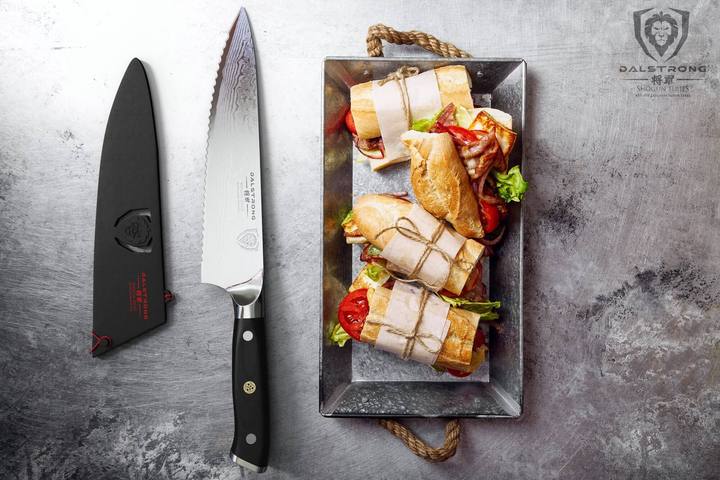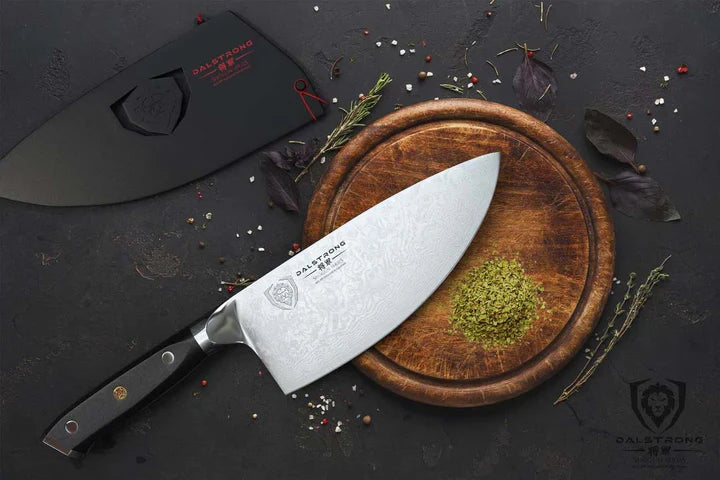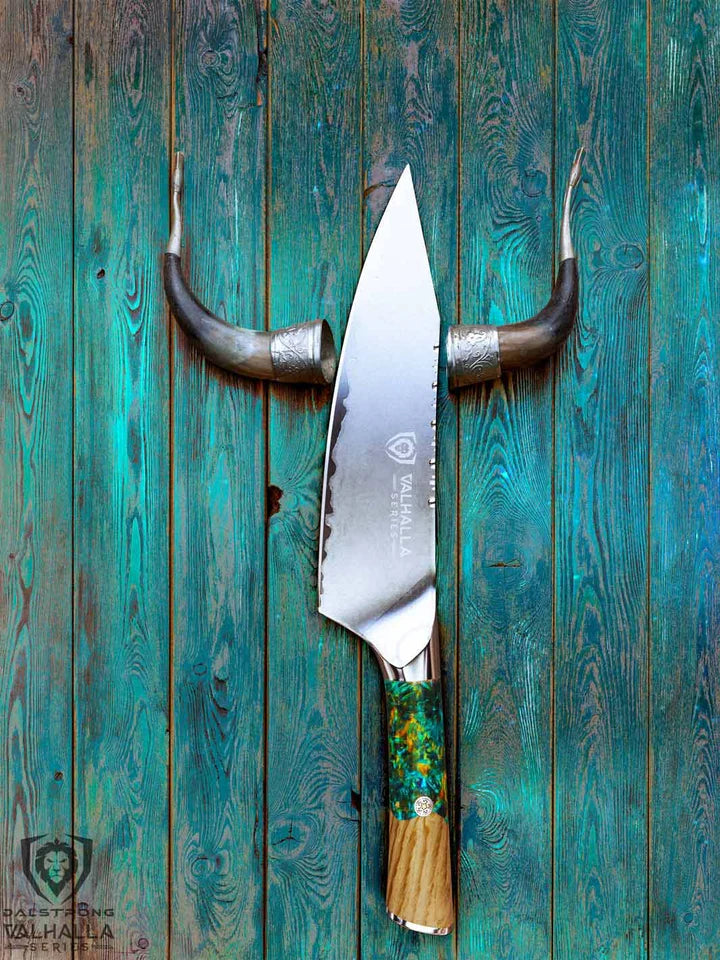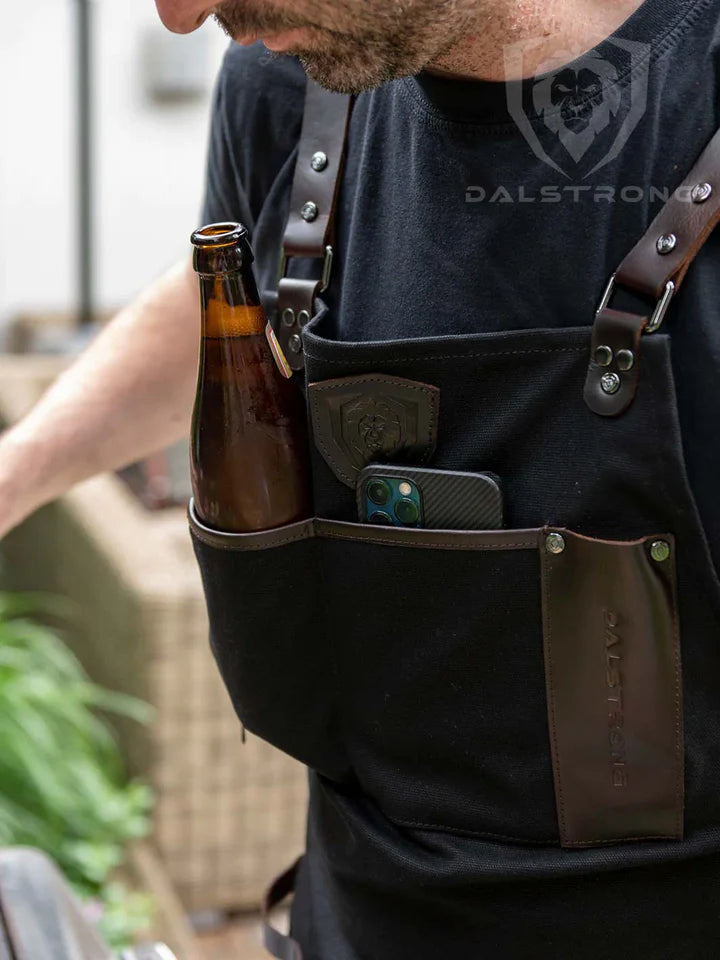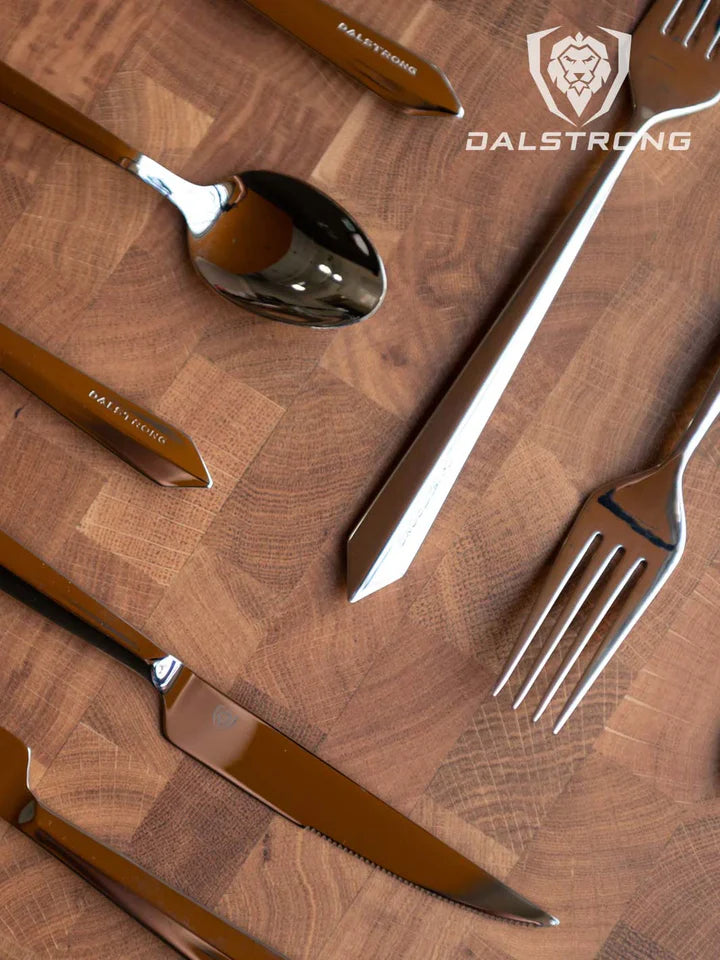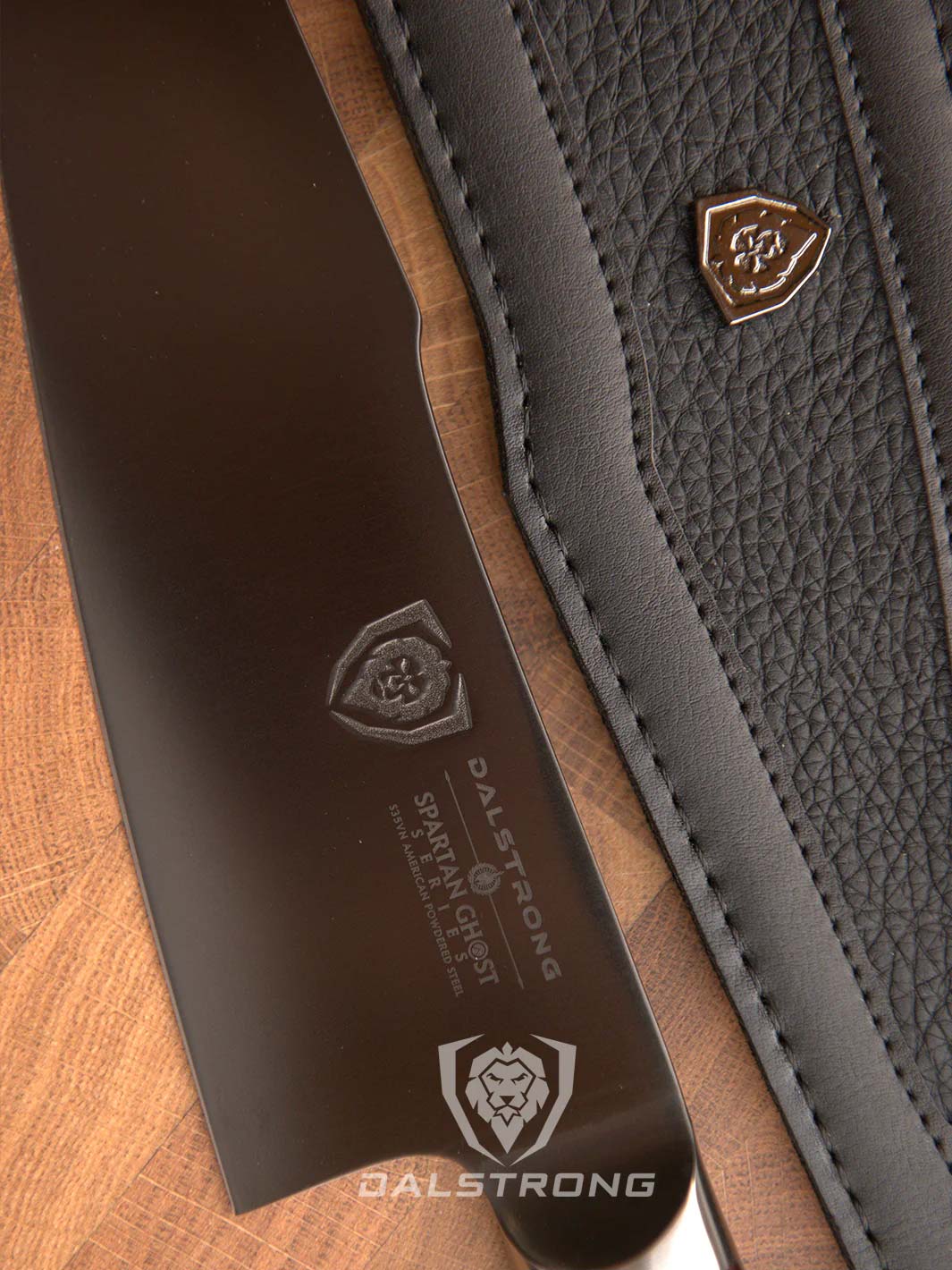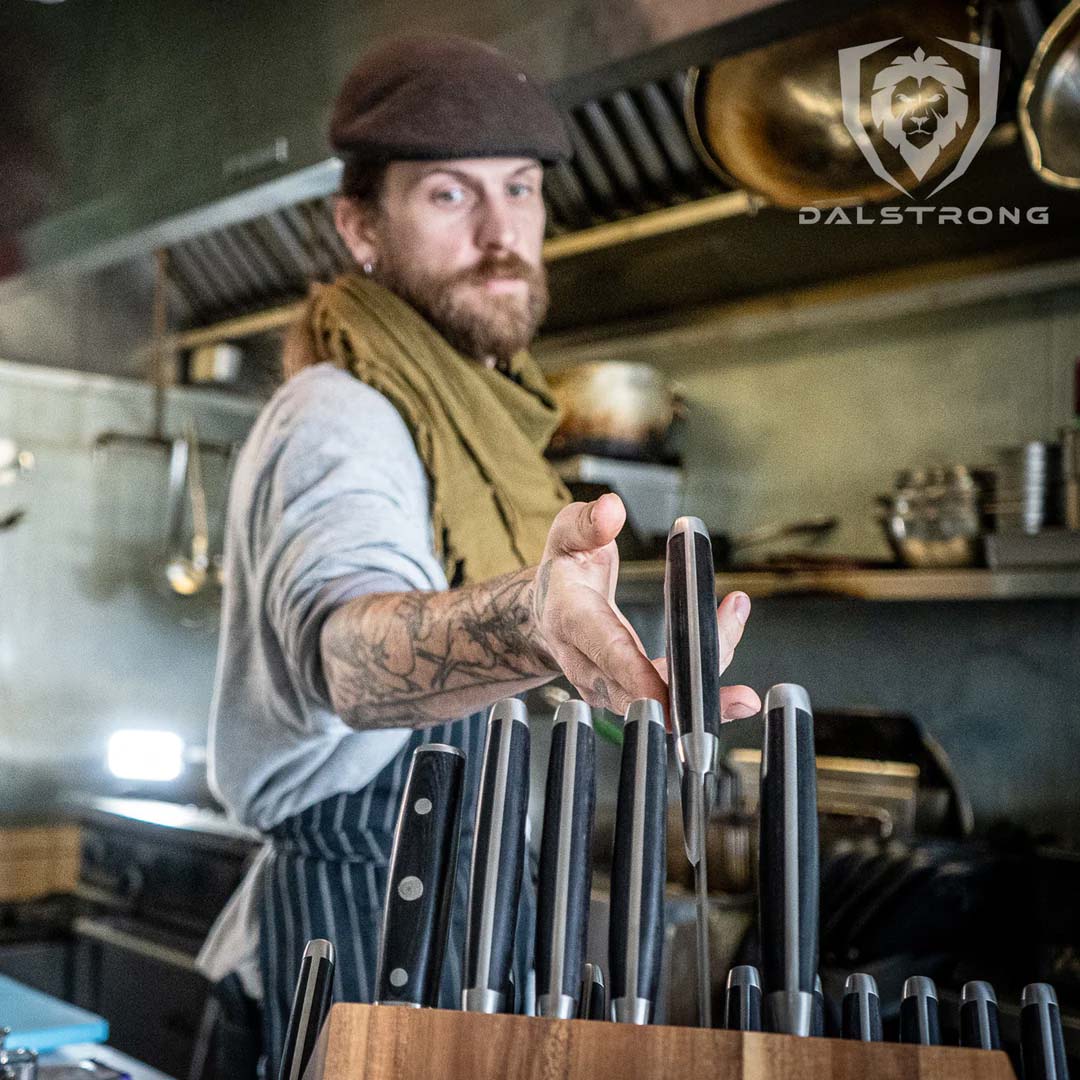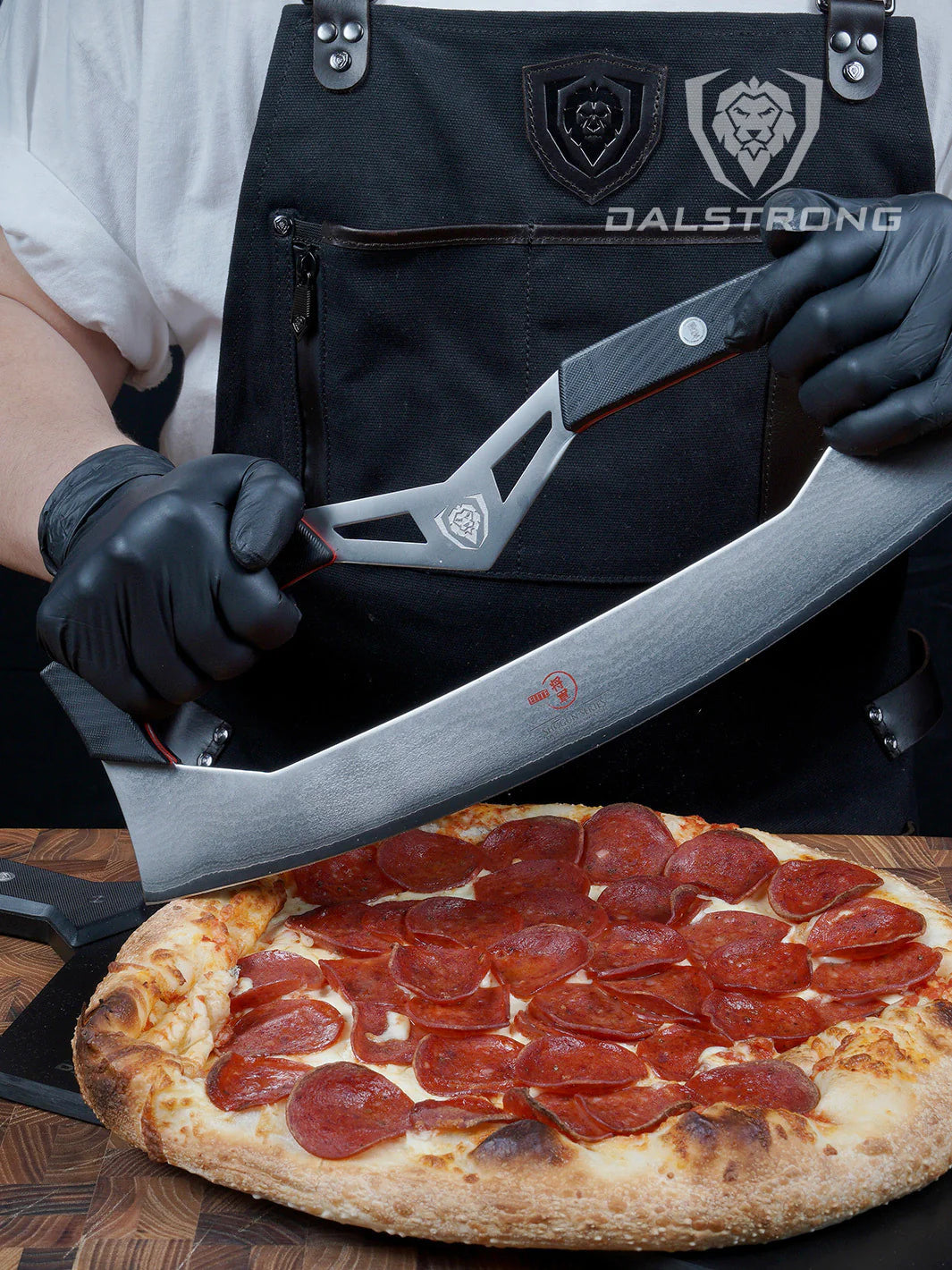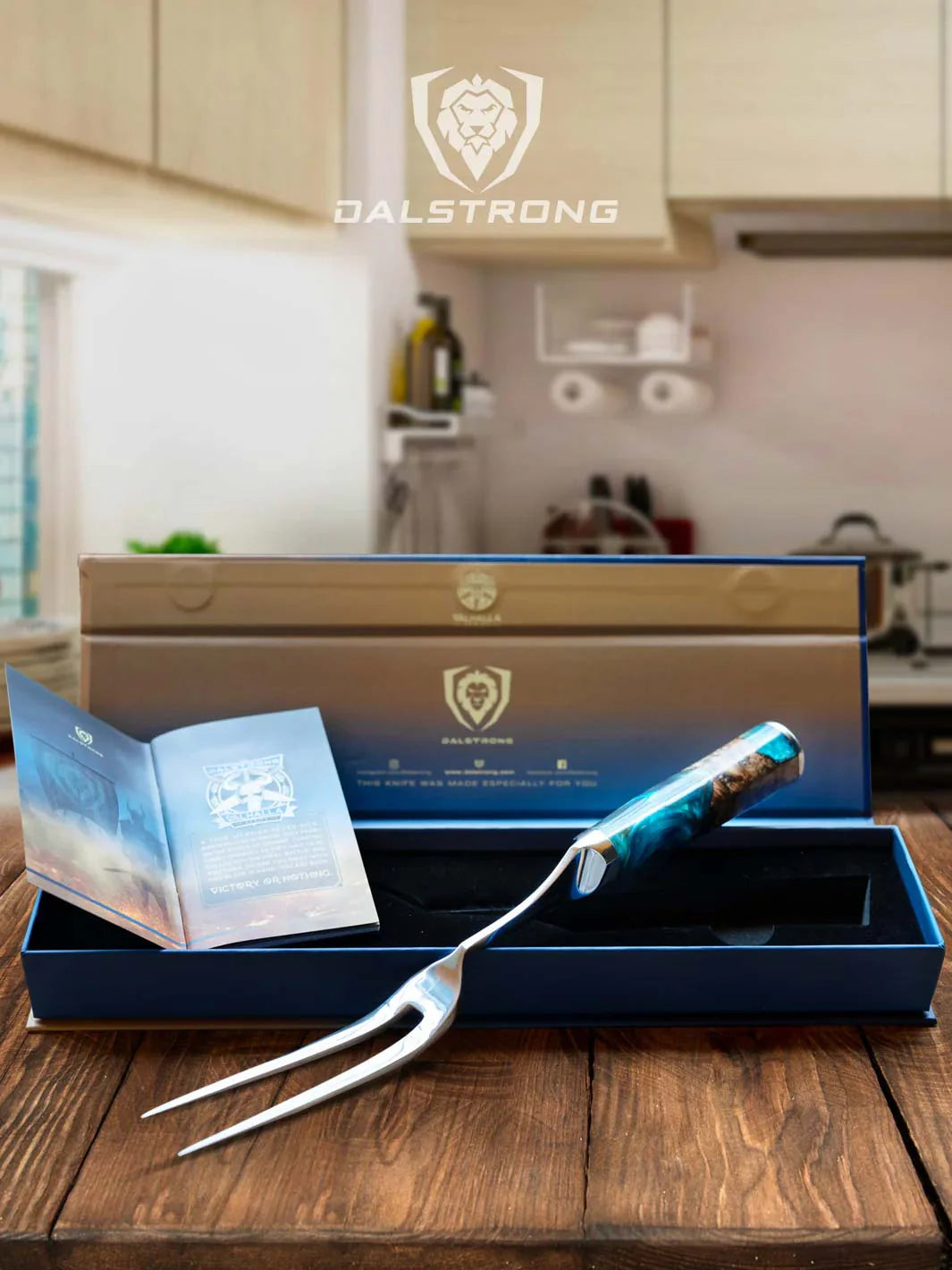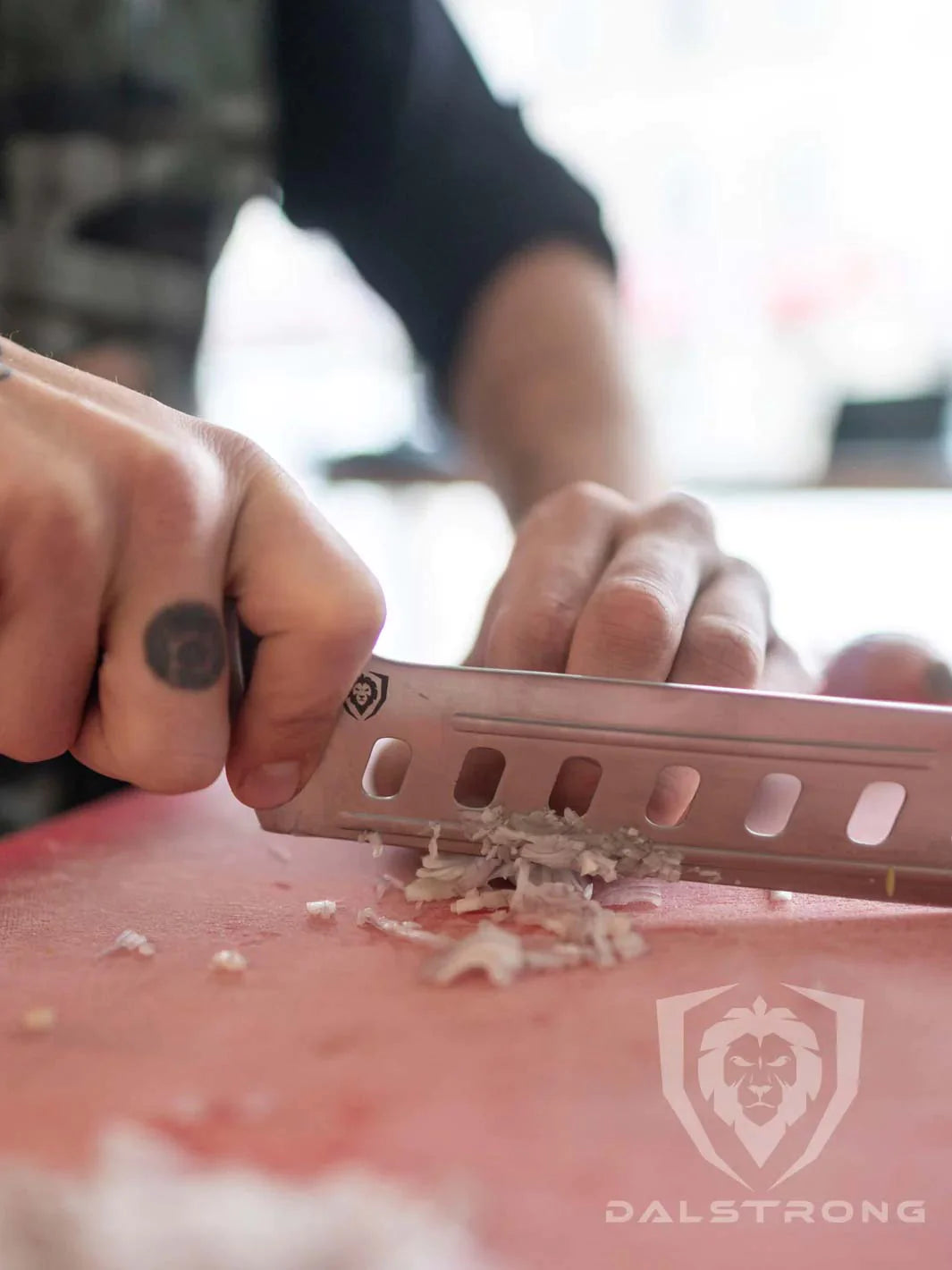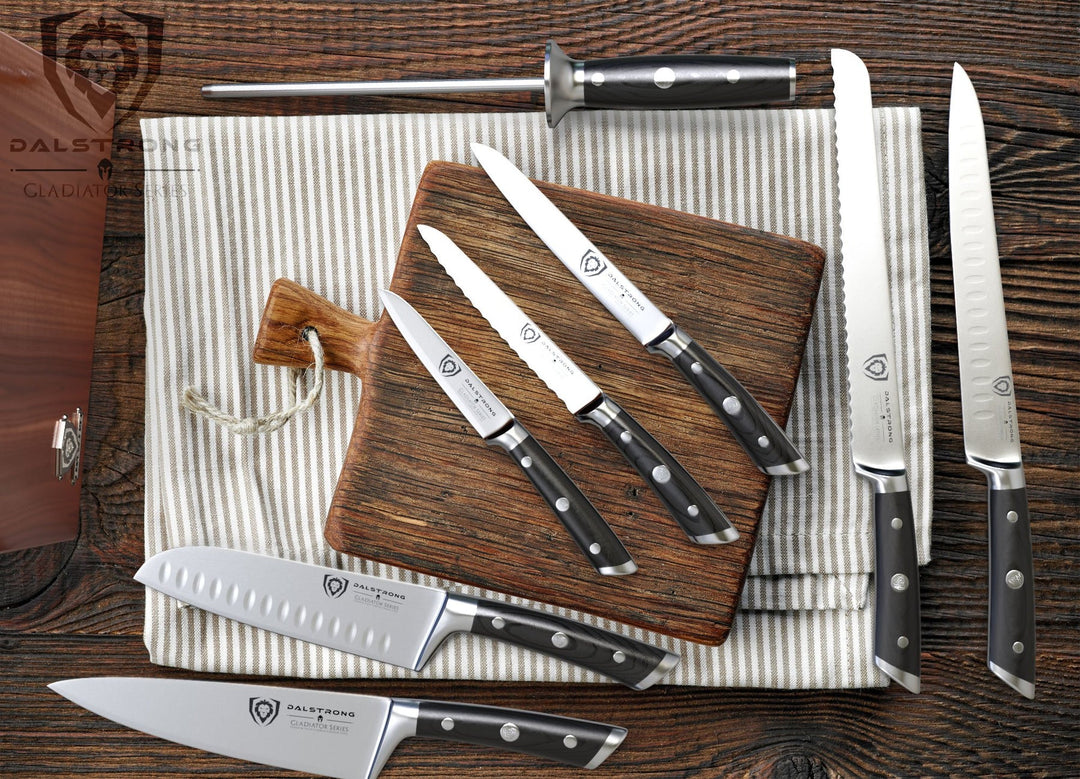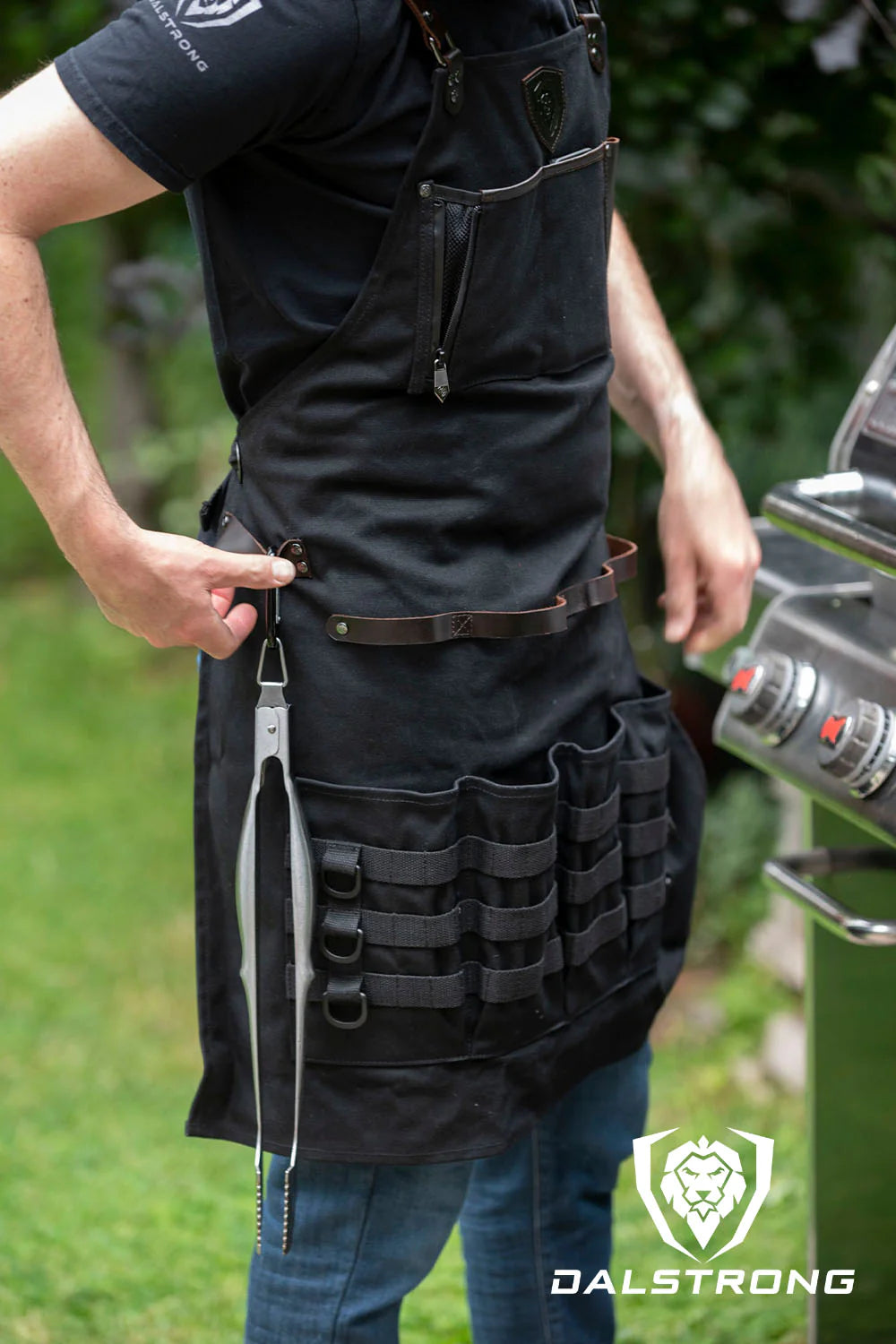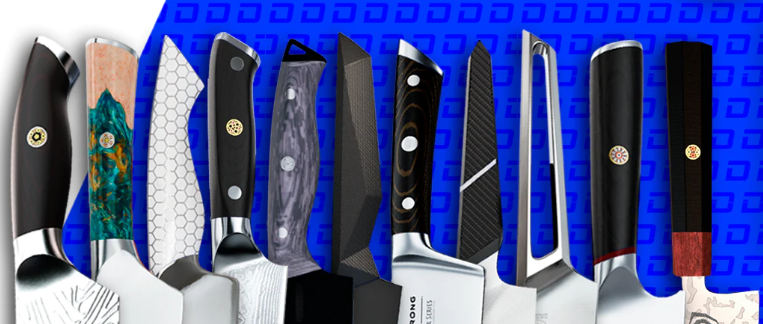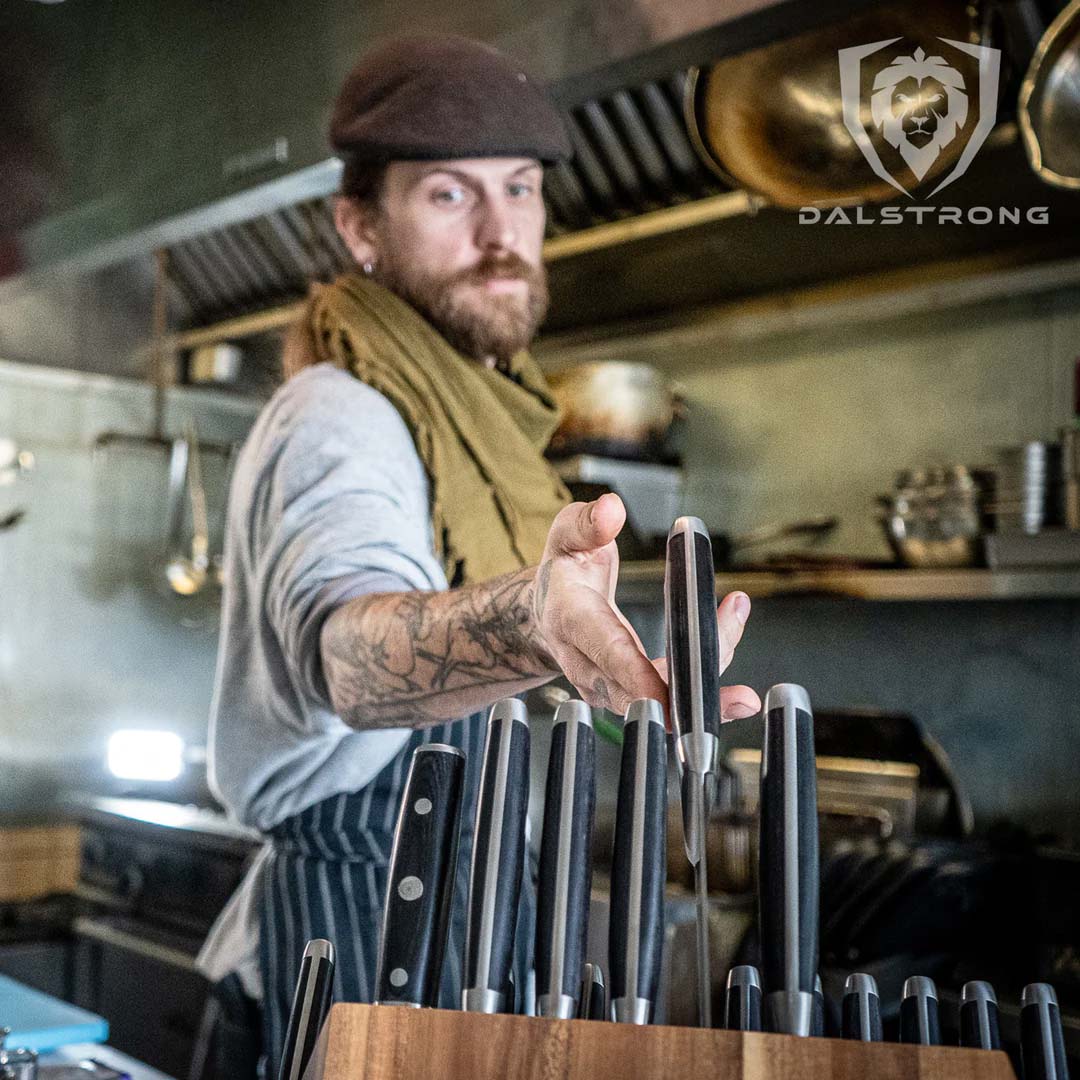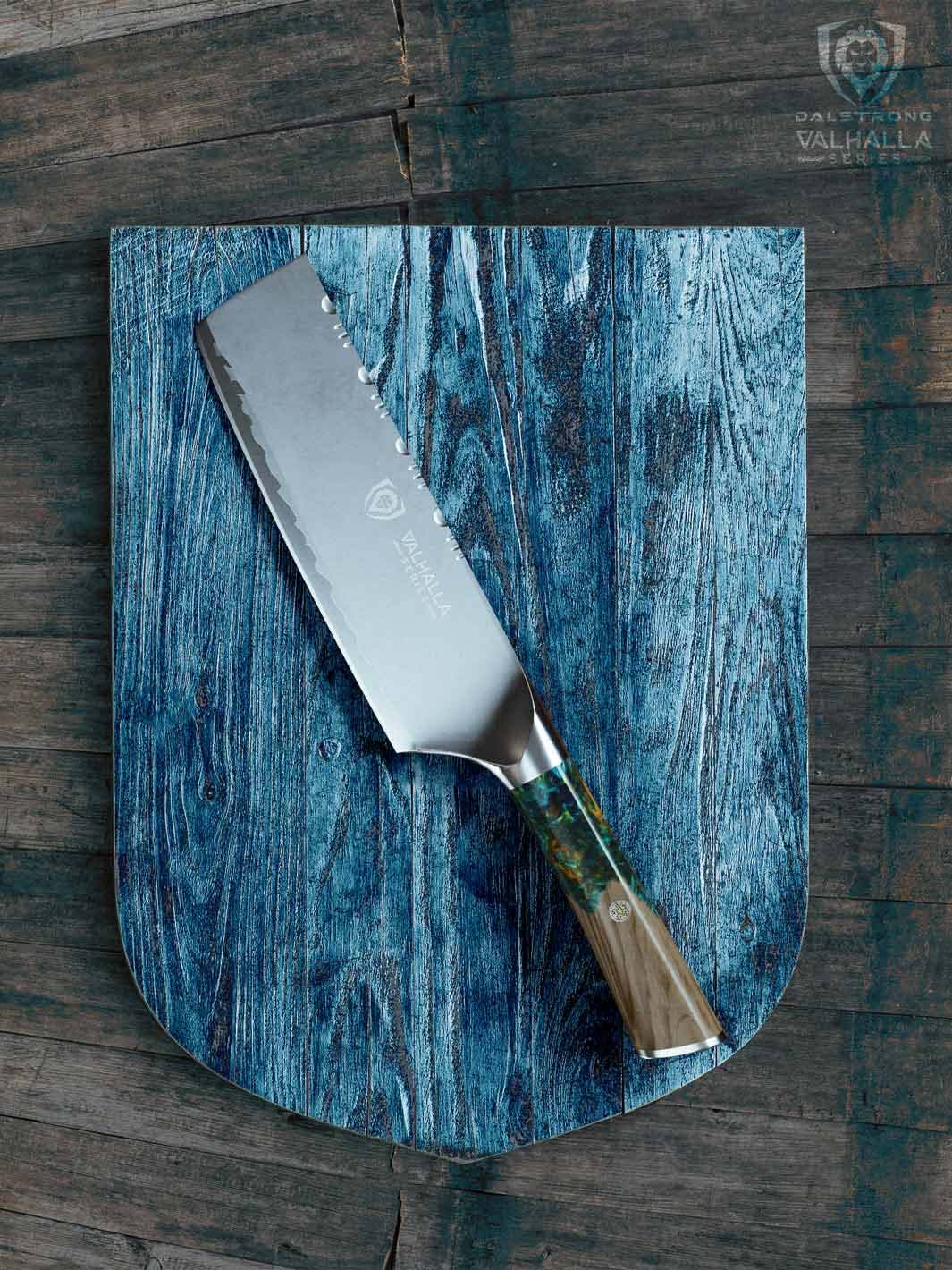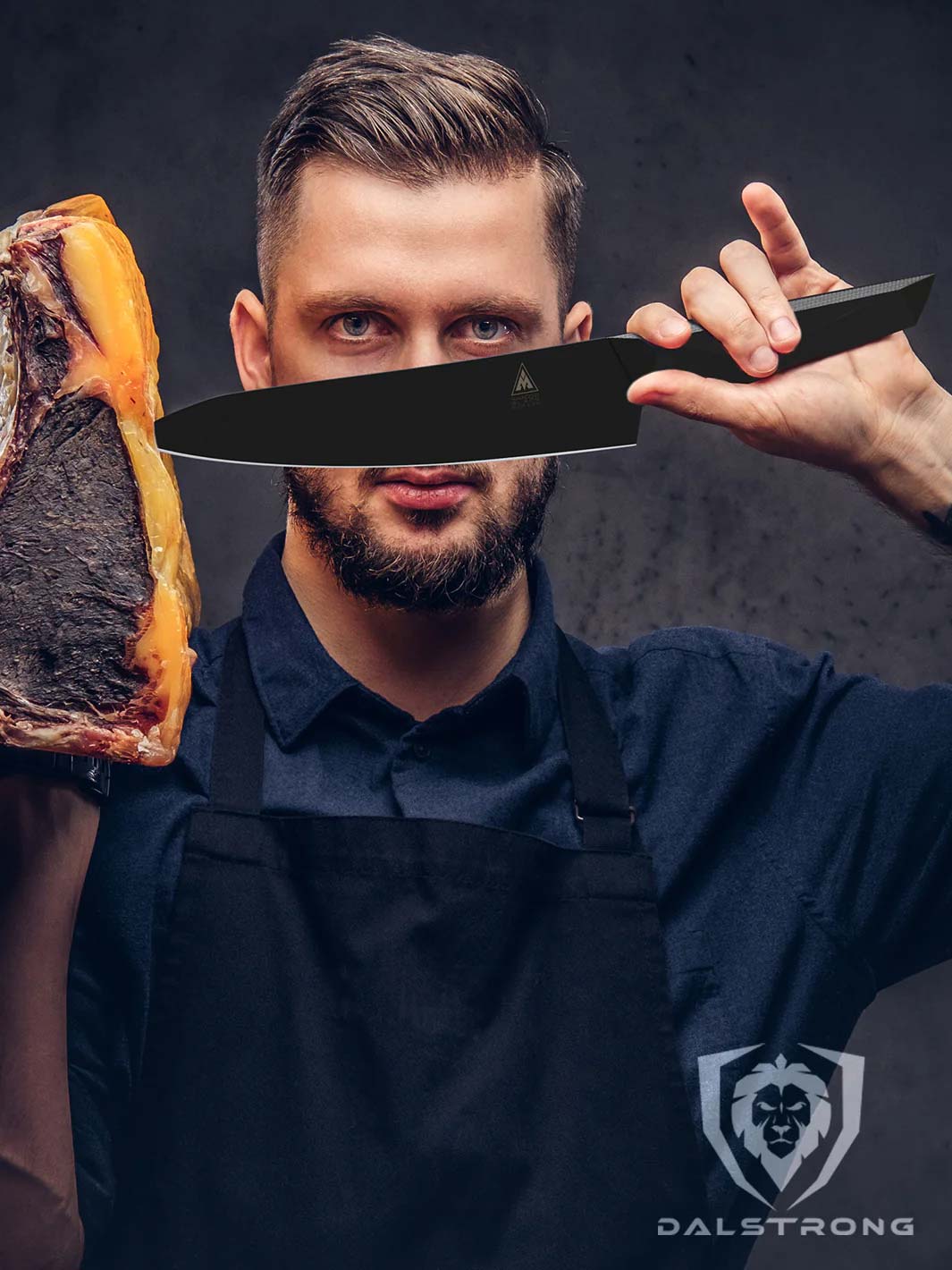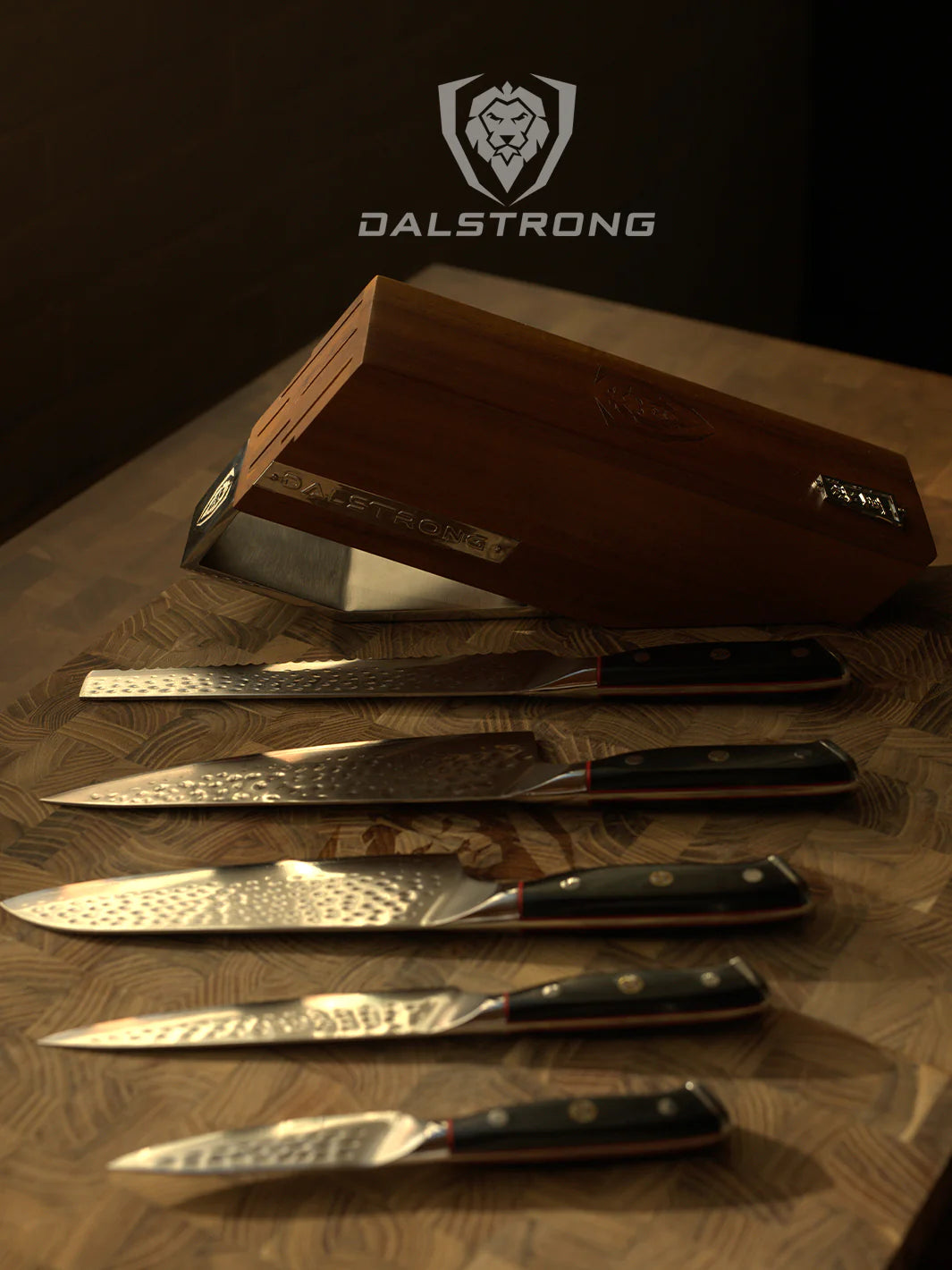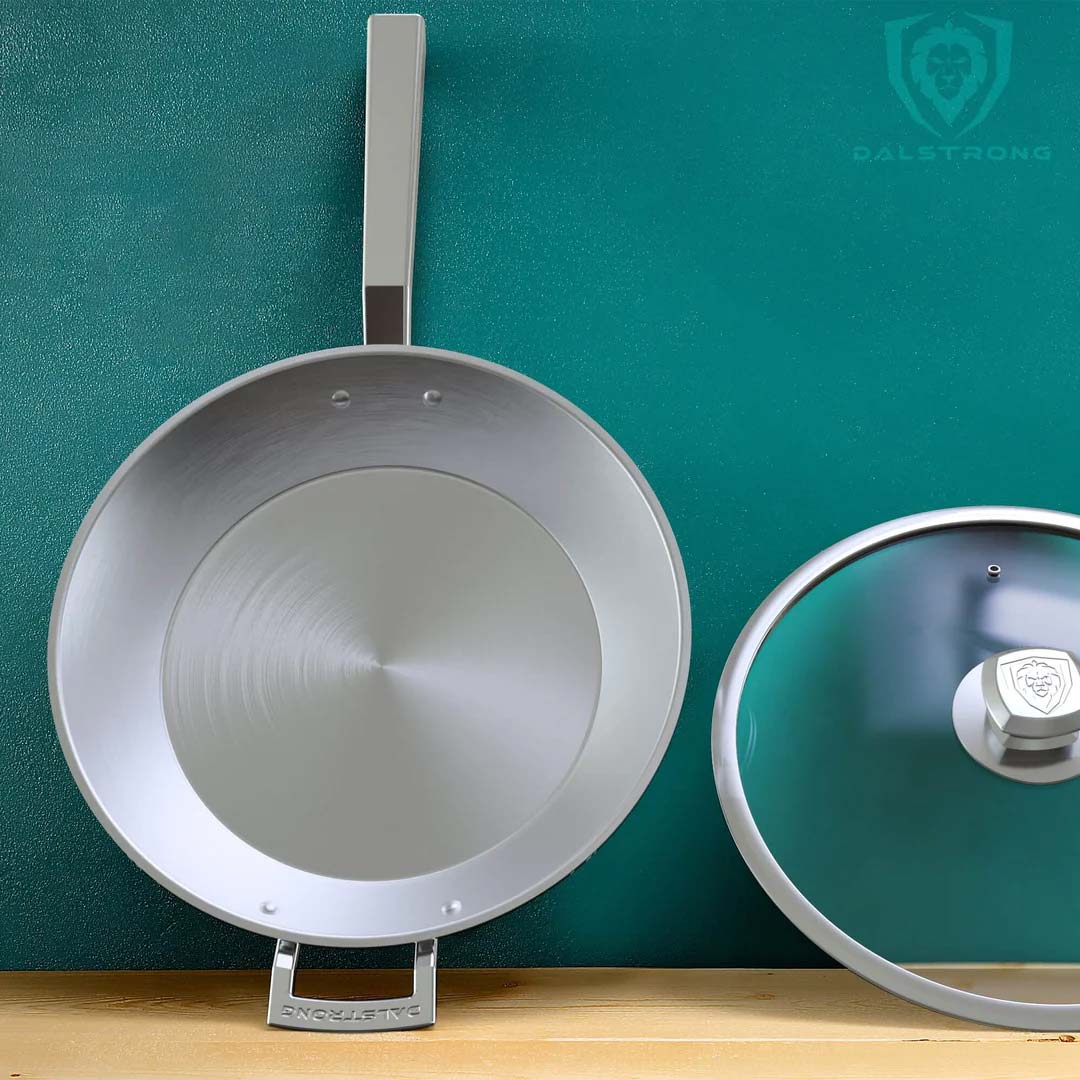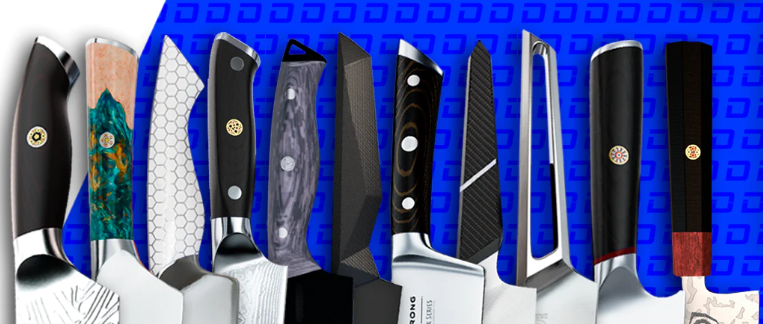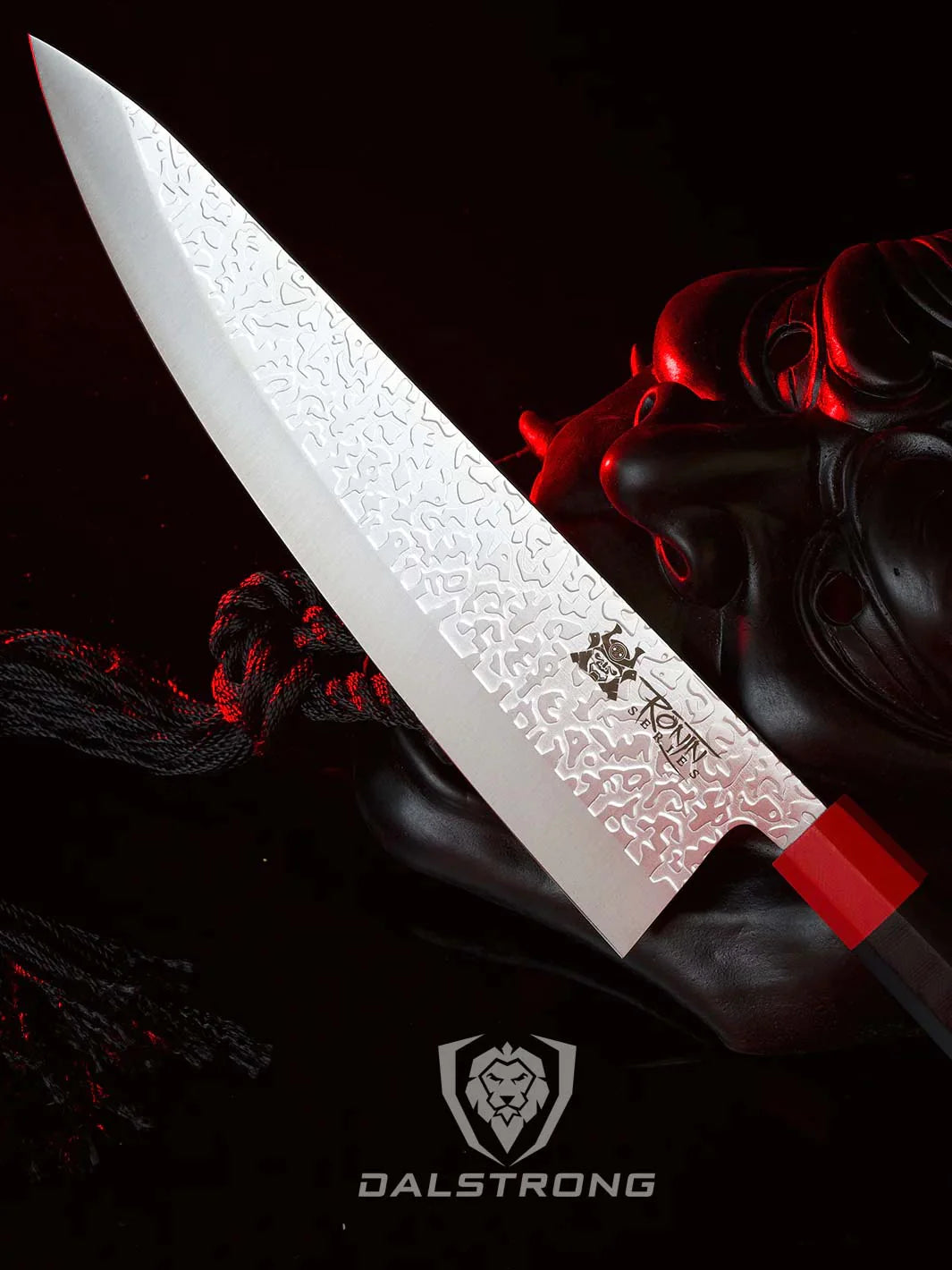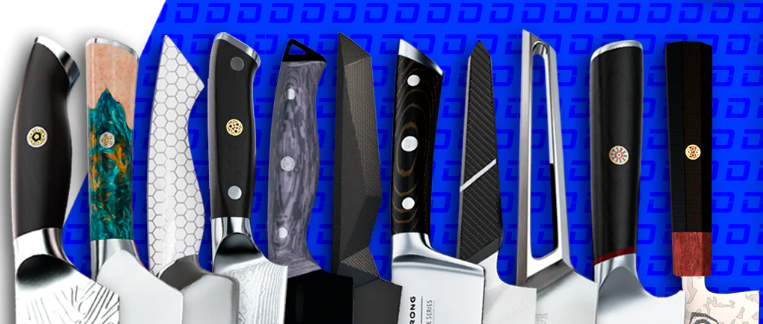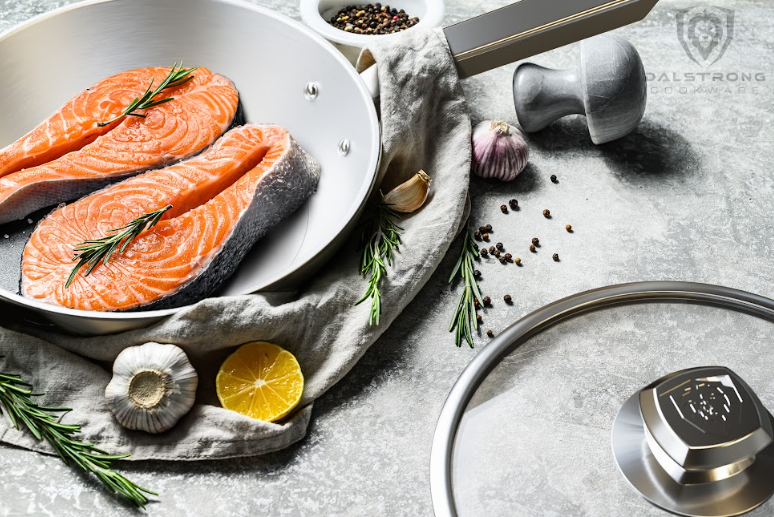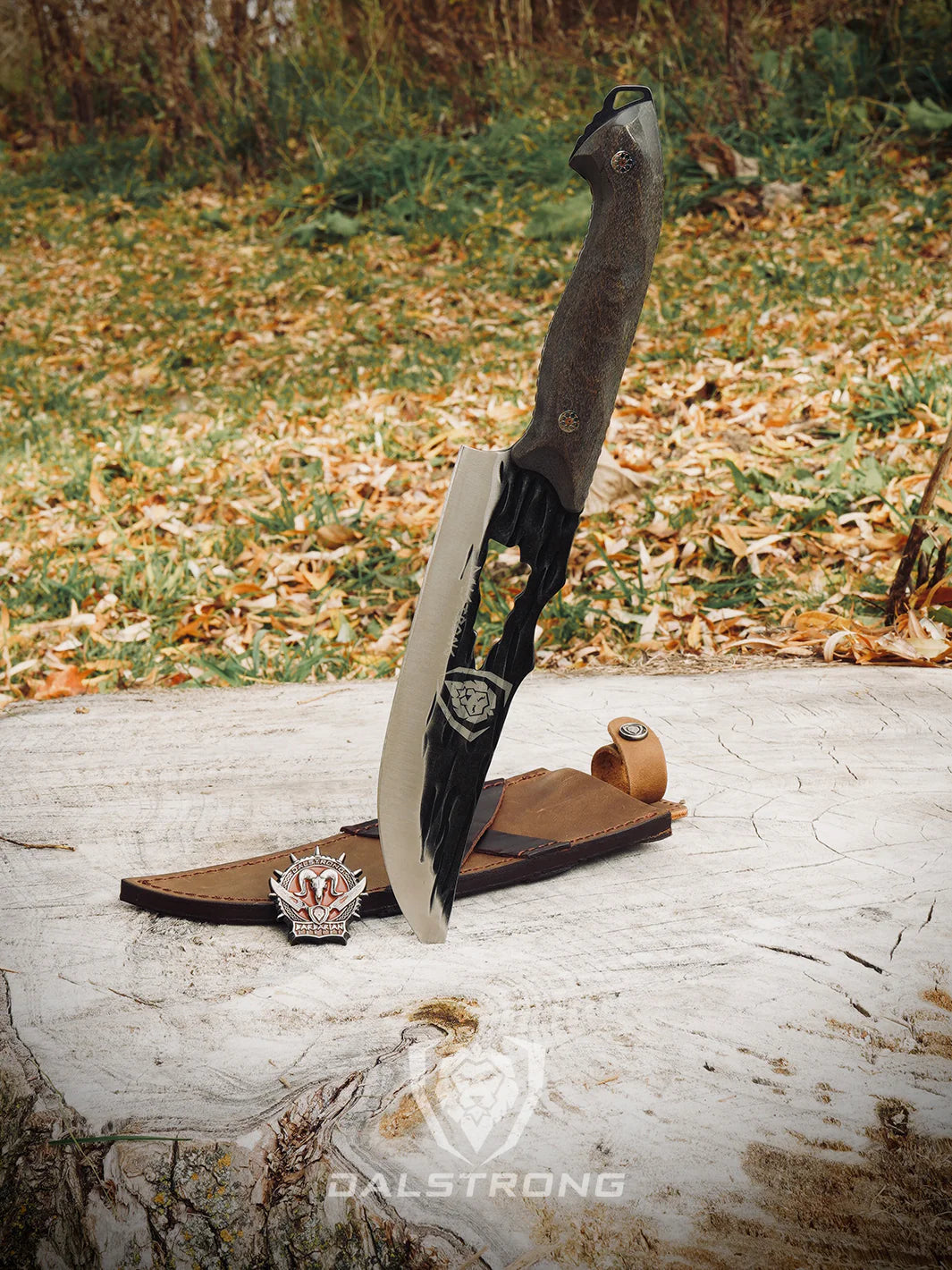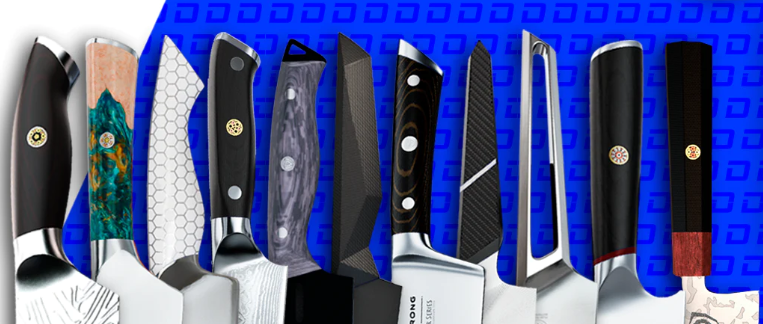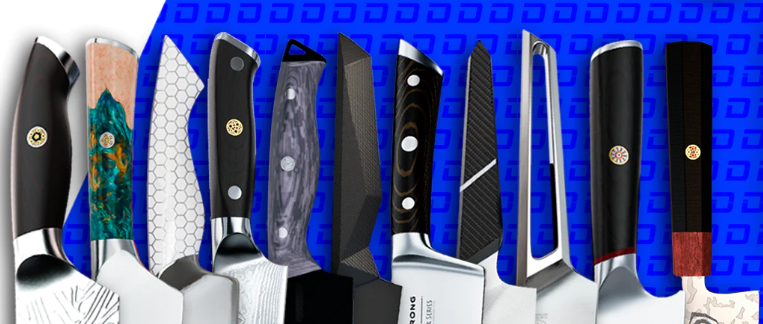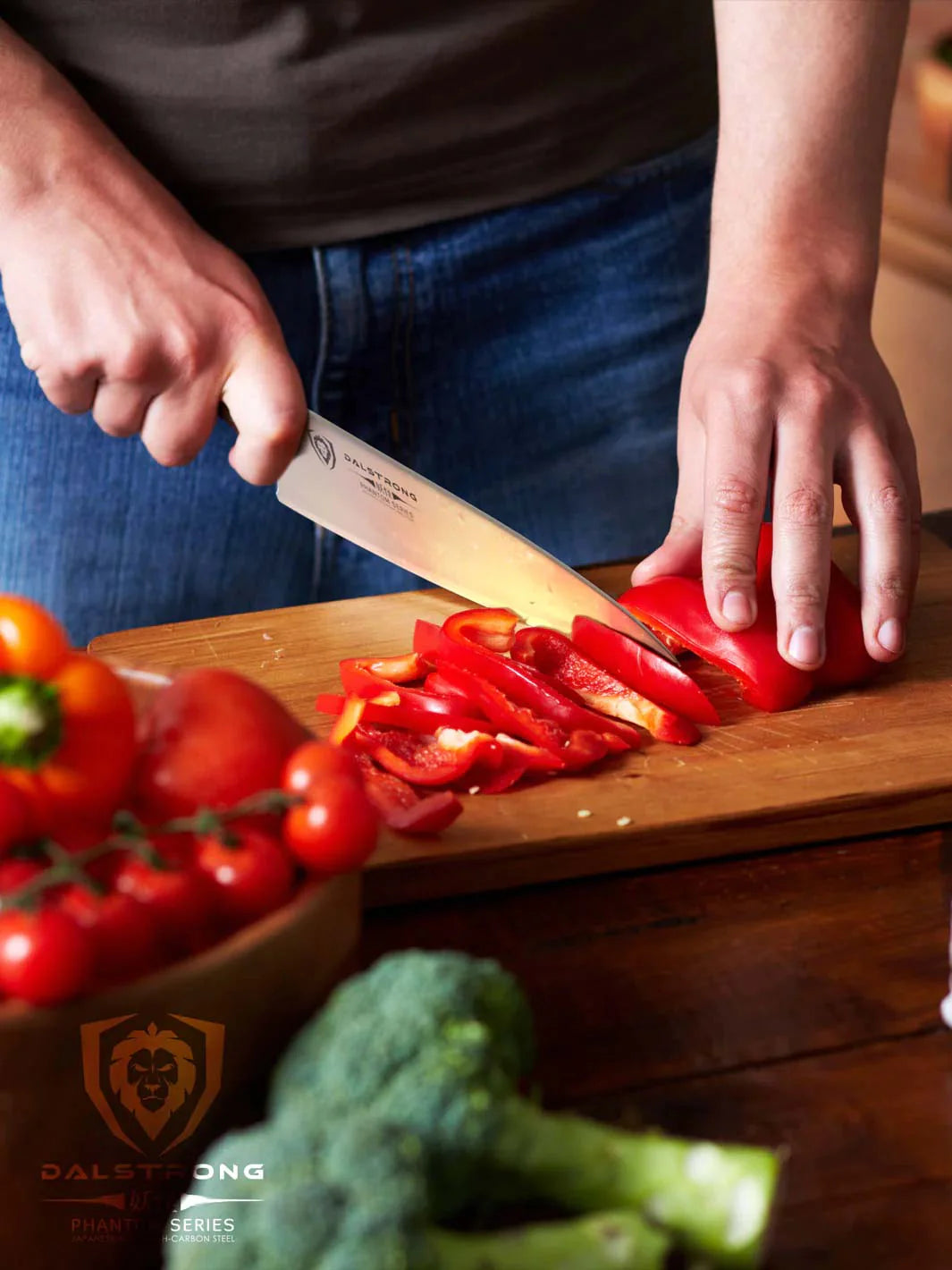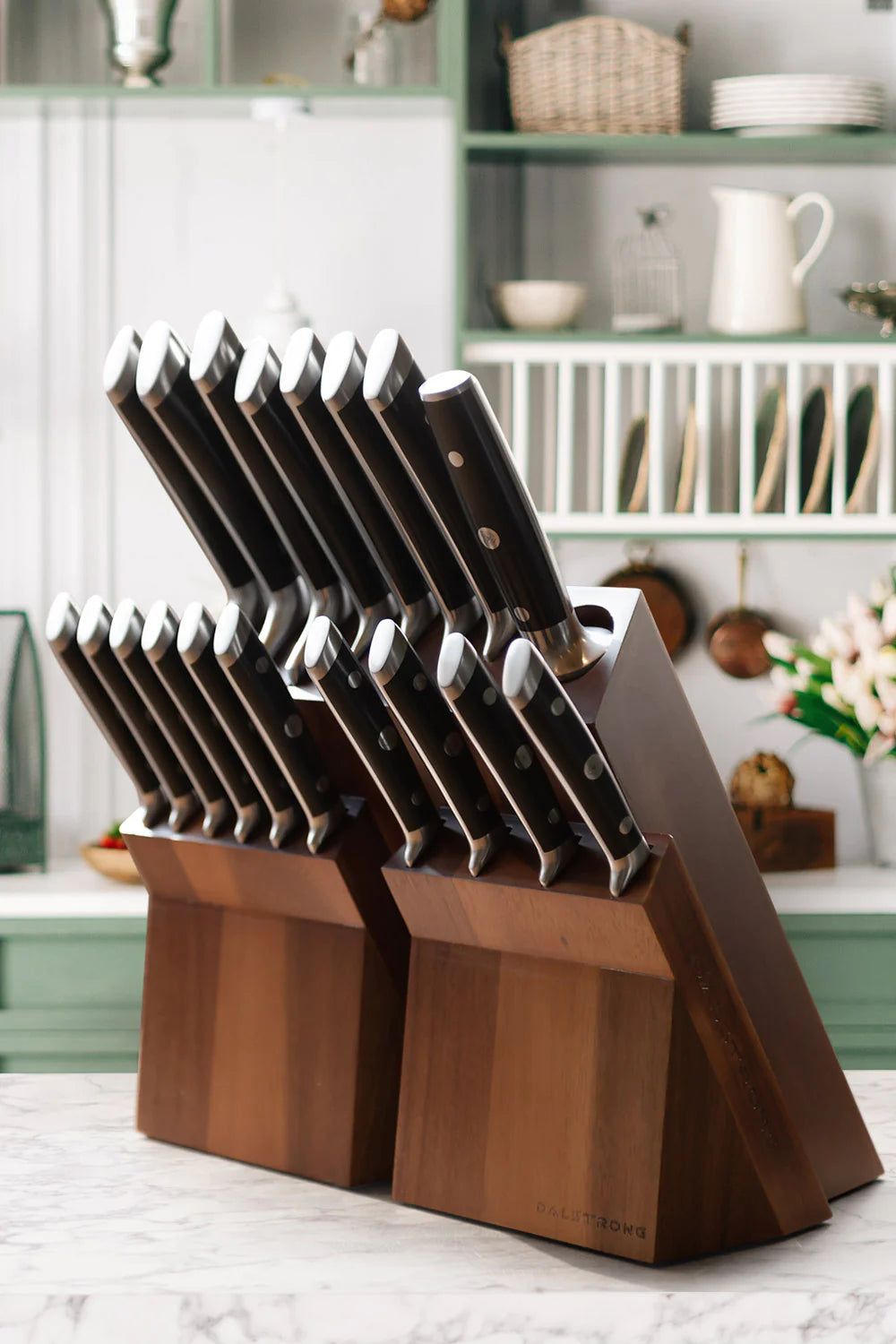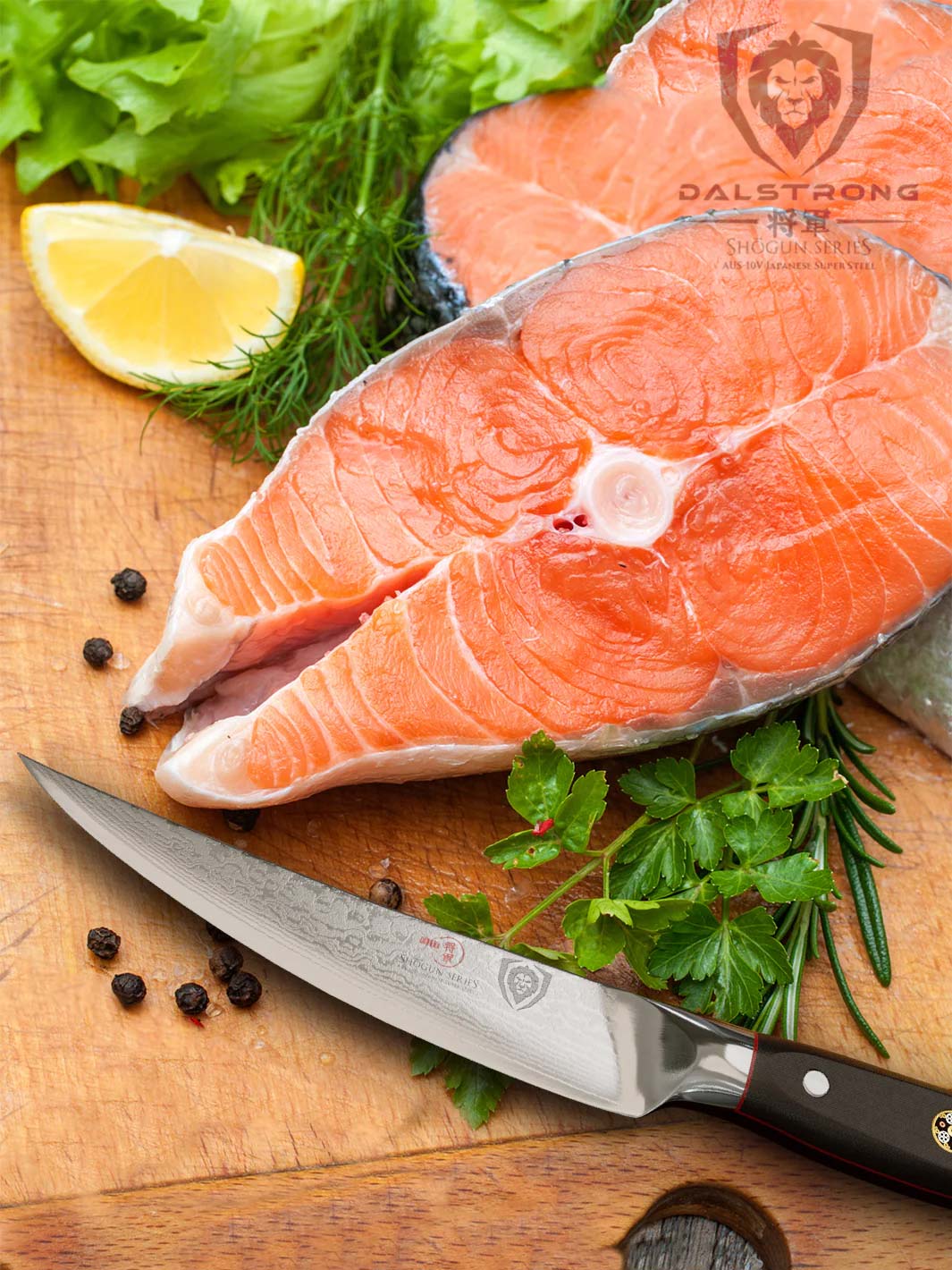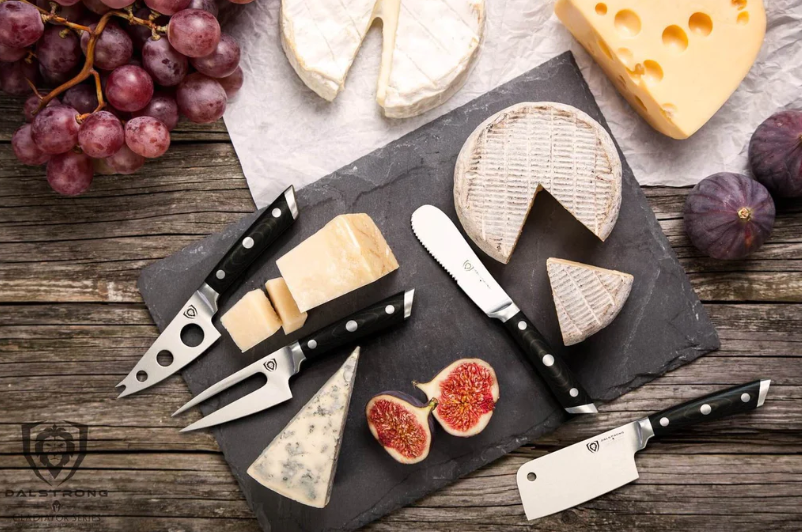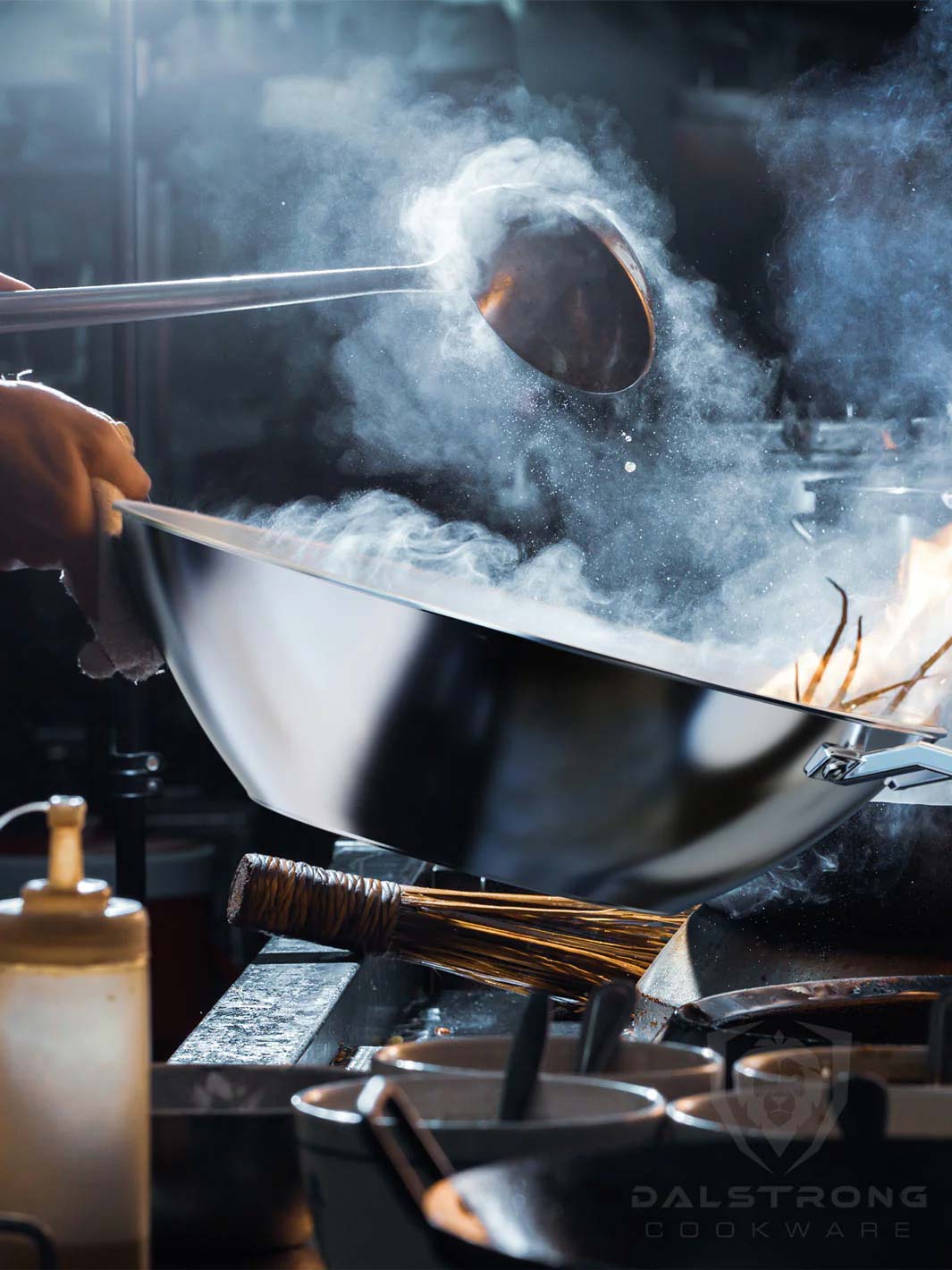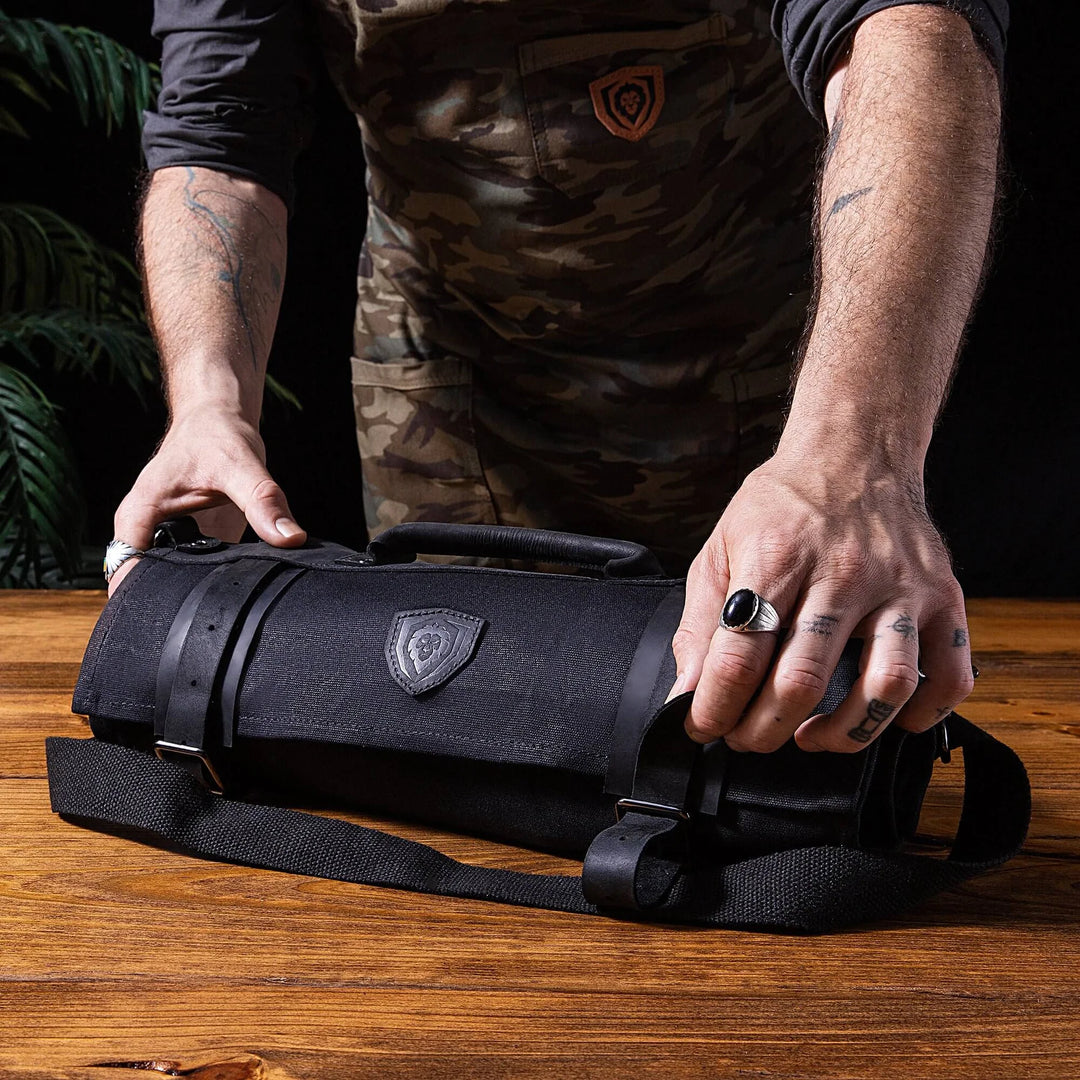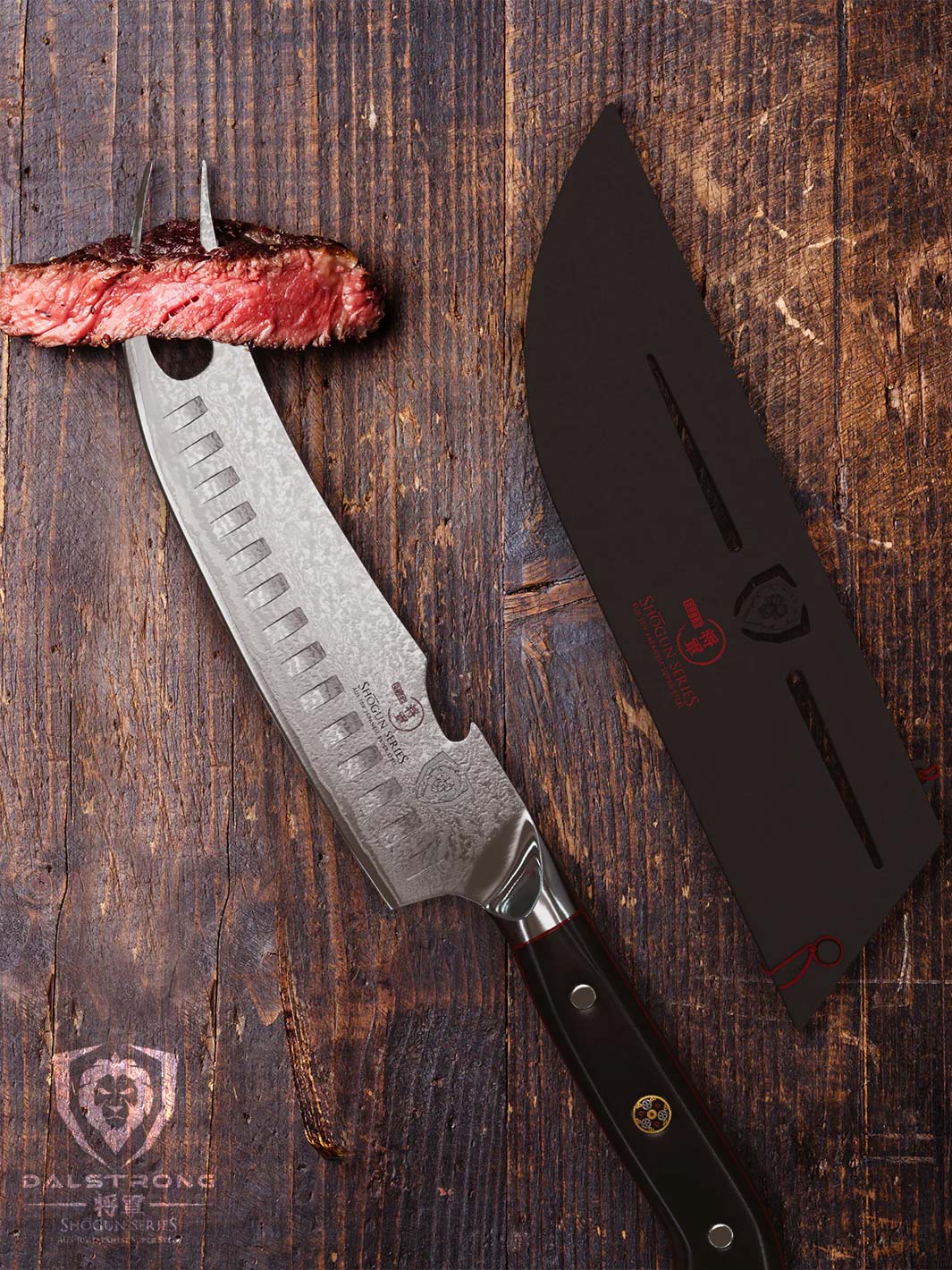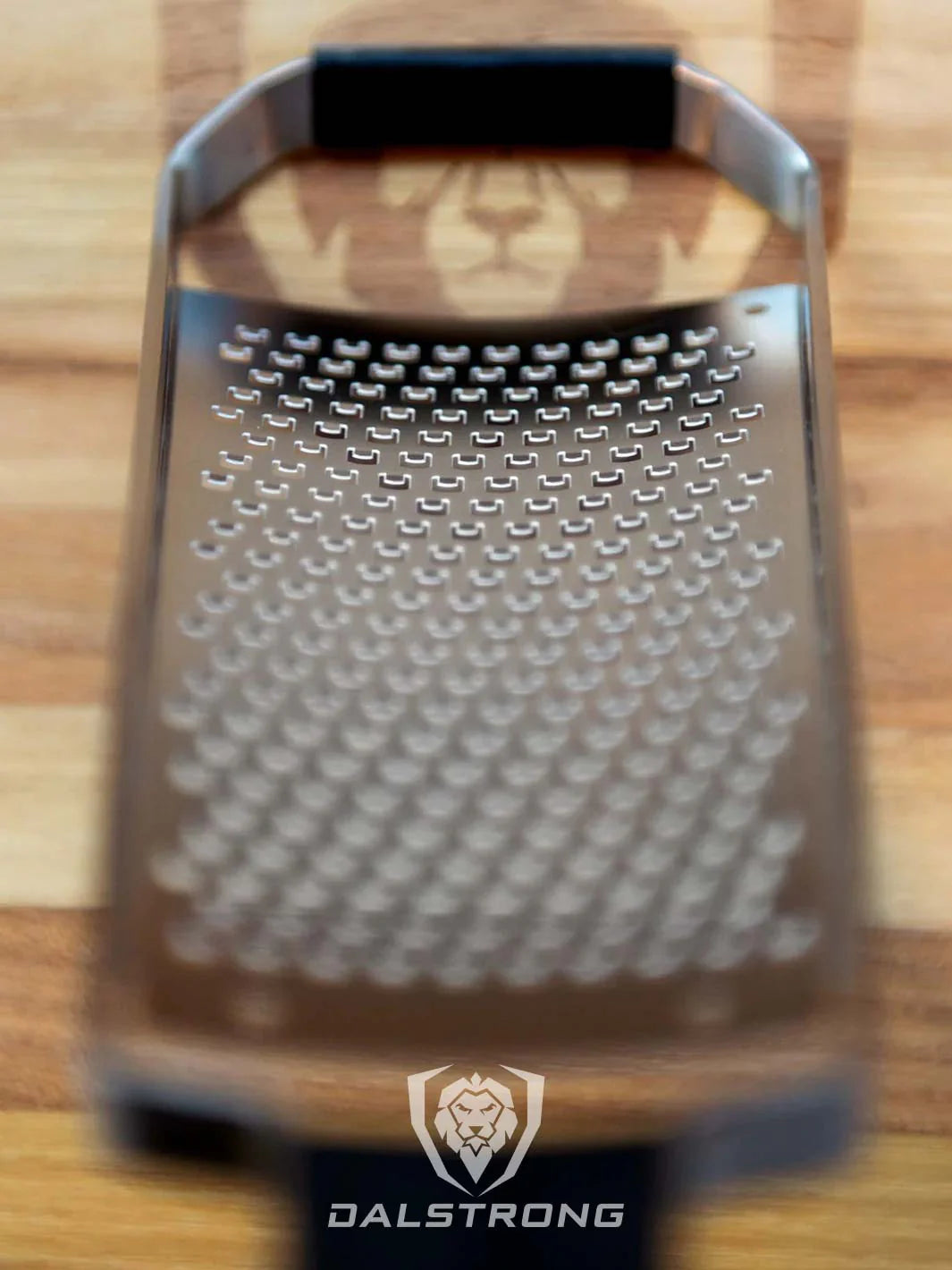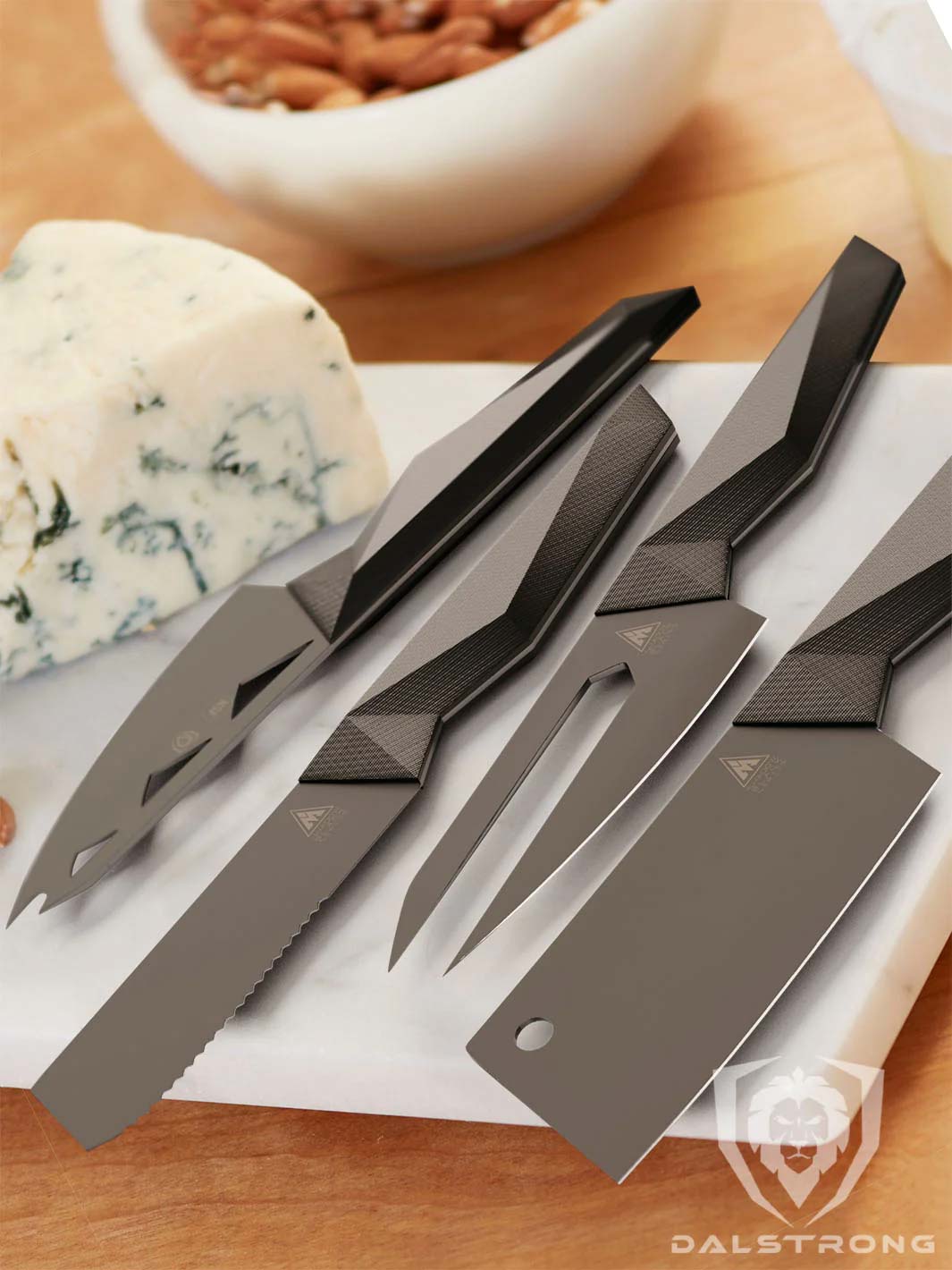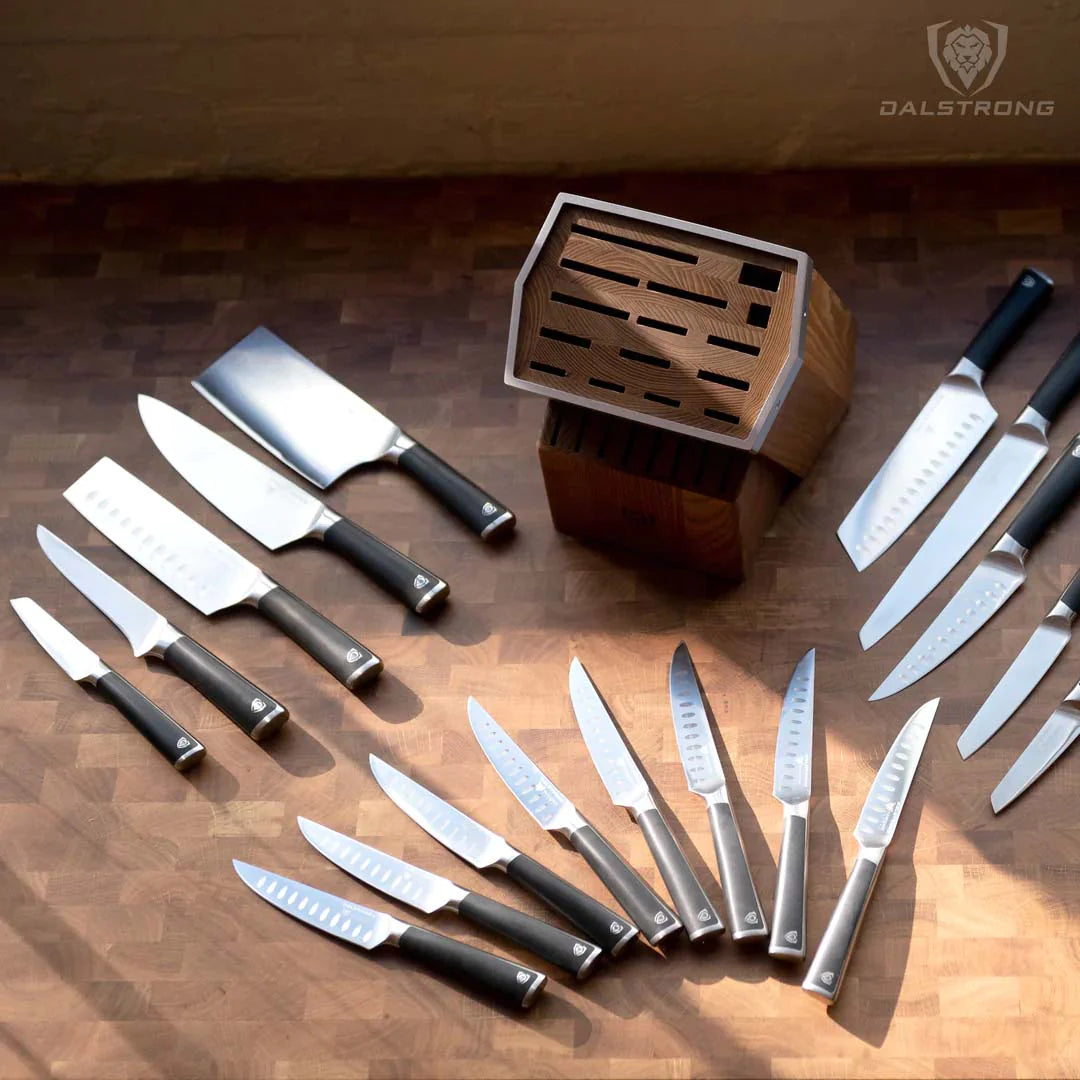Best Serrated Knives: What To Look For And How To Use Them
7.5'' Serrated Chef's Knife | Shogun Series | Dalstrong ©
The Best Serrated Knives
- Bread Knife 10.25” | Shogun Series
- Serrated Bread Knife 9” | Phantom Series
- Bread Knife 8” | Frost Fire Series
- Serrated Sandwich, Deli & Utility Knife 6" | Gladiator Series
- Serrated Utility Knife 5.5” | Crusader Series
- Serrated Utility Knife 5.5” | Gladiator Series
- Serrated Chef's Knife 7.5" | Shogun Series
- Serrated Chef Knife 7.5” | Gladiator Series
- Dual Sided Chef's Knife 8" | Gemini Twin Blade
- Serrated Paring Knife 3.75" | Gladiator Series
- Serrated Paring Knife 3.5” | Shogun Series
- Extra Long Serrated Slicer 14" | Gladiator Series
- 4-Piece Serrated Steak Knife Set | Gladiator Series
5.5'' Serrated Utility Knife | Crusader Series | Dalstrong ©
When it comes to necessities in the kitchen we immediately think of a good cutting board, some sort of frying pan, and a versatile kitchen knife (and sharpener). But if you’re anything like me, it’s quite possible that you enjoy freshly baked bread more than anything on earth. If that’s the case, you know how necessary a good serrated knife is to your personal wellbeing.
Serrated knives are often known as bread-cutting knives, but they can also slice a solid veggie, a quiche, or even a roast chicken. Don’t underestimate the power of a finely crafted serrated blade.
We’ll walk you through exactly what this type of knife is, how to source out the ideal serrated knife, and give you our breakdown of the very best serrated knives to buy for different use cases. We’ll be sharpening your knife knowledge throughout and cover any lingering questions you may have at the very end.
1. What is a Serrated Knife?

8'' Bread Knife | Frost Fire Series | Dalstrong ©
A serrated knife is best known as the classic bread knife you use to slice your morning bagel. While we love a good bread knife here at Dalstrong, there are many other knives that fit into the serrated category. A serrated knife is quite simply any type of knife with a serrated blade. In other words, a blade that instead of appearing smooth, with a straight edge has jagged edges to it, often referred to as teeth.
Serrated knives are ideal for cutting your sourdough loaves, your bagels, and any type of fully loaded sandwich. But if they are made well the blade can easily slice through just about anything from a roast to a perfectly ripe tomato, without having to keep your knife sharpener on hand at all times.
2. What to Look For in a Serrated Knife
Phantom Series 9" Serrated Bread Knife
Not all serrated knives are created equal. We’ve all had that one time in college where we tried cutting a slightly stale loaf of bread with our less than stellar dollar store bread knife. No matter how many times your roommate gave you the sharpener it still didn’t slice. Maybe some of you took that as a sign that serrated knives weren’t for you. While I feel that frustration, I really do, I urge you to reconsider.
A serrated edge knife can be absolutely life-changing, especially for those gluten lovers among us. You’ll want to keep in mind the quality of the knife first and foremost, followed by safety, and budgetary restrictions. I promise you a serrated knife can be a fairly cheap investment that you’ll savor for years of bread slicing to come.
Quality
- You’ll want to take extra note of the serrated blade. What type of stainless steel is it made from? How are the teeth shaped? How sturdy does the sharp knife feel in your hand? What type of grip does it allow you?
- You want your knife to be able to cut through bread without tearing it to shreds, or sharpening again and again, which means it will have to have a relatively narrow blade angle. The less surface area the knife has the more likely you will be to retain the shape of whatever it is you’re slicing. That way the tomato knife doesn’t completely destroy the tomato.
- You’ll need the knife, as all knives, to be strong and durable with teeth that aren’t too pointy. If they are too pointy they may tear the freshly baked bread you’re undoubtedly slicing into each morning. Keep in mind, however, that there are several different types of serrated blades. We’ll cover the pros and cons of each below.
Safety
- I’ve heard many a tale of an early morning bagel slice gone wrong. Safety is always something to keep in mind when it comes to knife sharpening and knife shopping, but particularly when it comes to those serrated edge blades you want to be extra cautious.
- Choosing a brand that you trust and having a backup whetstone or sharpening rod on hand to sharpen that blade to perfection is key to maintaining a safe cut every time.
Price
- Understanding your budget and its constraints should always be something you consider as you prepare to purchase just about anything.
- That said, investing in a proper serrated knife doesn’t mean you have to break the bank. There are a variety of stellar options ranging from as low as $30 to as high as a couple hundred.
3. The Best Serrated Knife For Every Kitchen Task
A. Bread Knives
1. Bread Knife 10.25” | Shogun Series
There isn’t any type of loaf that is too big or too long for this serrated bread knife to handle. With its sleek ‘Tsunami Rose’ design and impeccable Japanese AUS-10V stainless steel, this is the most badass bread knife money can buy.
Pros
- 67-layers of high-carbon stainless steel cladding means that this is arguably the best in the business in terms of blade strength, durability, and stain resistance.
- The knife is 10.25” so it is absolutely ideal for handling the longest baguette known to man, slicing easily straight down the middle, without any added sharpening.
- The handle is ergonomic and perfectly crafted for agility and comfort, meaning despite its long length you can still have small hands and sling this knife around comfortably.
Cons
- While this knife is absolutely top of the line, the price point also reflects that. For a similarly long blade at a lower price point, try the Gladiator Series 10” Serrated Bread Knife.
- Some people may prefer a smaller blade length. In which case, I’d recommend a 9” option like the Bread Knife 9" | Shadow Black Series | NSF Certified | Dalstrong ©
- The style of this knife is impeccable, in my opinion, but for those looking for a less classic look, they may prefer a different style.
2. Serrated Bread Knife 9” | Phantom Series
Another absolutely stellar bread slicing knife, this is 9” of straight power. With premium Japanese AUS-8 steel and a price point you just can’t beat, this is the type of bread knife you’ll want to buy for birthdays for the whole family.
Pros
- This is the middle ground of blade lengths when it comes to the best bread knives. The 9” blade enables thin, even cuts with just one single stroke.
- The absolutely stunning Japanese steel is hand sharpened to ensure an incredible blade edge so that your cuts are effortless and swift.
- The laminated pakkawood handle is carefully crafted to ensure maximum comfort as you slice away.
Cons
- I think that a 9” serrated blade is the sweet spot, but there are those that will either prefer a slightly larger 10” blade or the slightly smaller 8” option.
- Japanese steel, in my opinion, is the best there is, but if you’re partial to German or American steel consider a bread knife like the Bread Knife 9" | Shadow Black Series | NSF Certified | Dalstrong ©
- Again, if the classic steel and black handle combo isn’t for you I’d consider the following option.
3. Bread Knife 8” | Frost Fire Series
With an icy look, this serrated knife is not as traditional in terms of style as the other two on our list but packs an equally powerful punch. The snake skin handle ensures that this super sharp knife would be at home in any modern kitchen.
Pros
- Made from a 7-layer high-carbon, high-chromium 10CR15MOV steel that has added cobalt and expert heat treatment, you can be sure this knife is meticulously designed and built to last.
- It has a lightweight construction and with its 8” blade is ideal for those of us that prefer a smaller knife to yield around.
- At 16-18 degrees per side, the sharpening has been elevated to perfection on this serrated knife. It’s ready to take on the most stubborn of day-old bread loaves.
Cons
- For those of you in the market for a less traditional knife, this all-white icy look is bound to please. But if you’re trying to follow a specific theme in your kitchen decor, it may not be the knife for you.
- While the price point is more than fair for this high-quality knife, there are cheaper options on the market.
- It is the smallest of our serrated bread knife blades. If you’re looking for a longer blade, this isn’t the one for you.
B. Utility Knives
A utility knife has its place in the kitchen because of its versatility to move from cutting up fruits and vegetables to carving a roast. While I personally prefer to use a chef’s knife and paring knife, for those that prefer less cleanup, or just owning fewer knives in general, the utility knife is a stellar option. Serrated utility knives provide even more room to play around, serving as the perfect tomato slicer.
1. Serrated Sandwich, Deli & Utility Knife 6" | Gladiator Series
This is the type of knife you want around the house anytime you have anyone over for lunch. It is absolutely the ideal knife for slicing through that perfect sub, without the whole sandwich falling apart.
Pros
- Forged from a single piece of high carbon stainless steel (ThyssenKrupp German X50CrMoV15 steel) the power behind this serrated utility knife will make anything it chops feel as smooth as butter.
- This knife is full tang meaning its robustness is absolutely off the charts.
- The G10 Garolite handle has superior strength and durability and won’t warp over time or in any stressful cooking scenarios.
Cons
- I don’t particularly prefer the shape of this blade. It’s a bit too thick and may make sharpening more of a task. For a more standard design, try something like the Serrated Utility Knife 6" | Shogun Series X | Dalstrong ©
- While this is a knife that seems to fit a particular niche (all things deli) I still think with its incredible price point it’s worth the investment.
- Utility knives tend to have smaller stainless steel blades. If 6” isn’t your jam, keep reading!

Minimalist and stylish this serrated utility knife ensures that food won’t get stuck on the blade as you glide through that perfect cut. Precision forged, ultra-sharp, and with that perfect 5.5” inch blade you’d be foolish not to add this to your shopping cart.
Pros
- This is as sleek as a stainless steel knife that you could possibly get with steel for both the blade and the handle. It just looks polished.
- Forged from ThyssenKrupp German stainless steel at 58+ Rockwell this is a knife of quality with a sharp edge that will last long into your culinary career.
- It is incredibly easy to clean with a hygienic design that leaves little room for food to stick around.
Cons
- The handle is designed for maximum comfort but also has a gaping hole in it which may make some novice chefs a bit nervous.
- While still reasonably priced, the price point on this particular serrated knife is slightly more than the Gladiator Series deli option.
- In terms of style, this may be a bit too futuristic for the more traditional folk.
3. Serrated Utility Knife 5.5” | Gladiator Series
The narrow blade on this classic utility knife design is ready to tackle the demands of any and every kitchen or even to keep as a high-end pocket knife. Its stain-resistant blade and tapered design ensure a perfect serrated cut without any tear.
Pros
- This serrated utility knife has a particularly tall blade height which I find incredibly helpful for food prepping. The height allows for more knuckle clearance and an easier chop.
- The blade is made from the finest German steel, which is absolutely top quality.
- The handle is triple-riveted, meaning you cannot get more durability than this serrated utility knife can supply.
Cons
- This is the most traditional utility knife, in terms of design, on the list. If you’re more experimental with your taste you might consider a different knife.
- While I think 5.5” is a fantastic length, some chefs prefer a 6” blade or even a straight blade.
- If you prefer Japanese steel in your knives, the Serrated Utility Knife 6" | Shogun Series X | Dalstrong ©may be a better fit.
C. Chef Knives
Everyone needs a good chef’s knife in their kitchen (along with a sharpening rod or sharpening tool). They are the first knife I’d buy on my starter pack to owning a fully stocked kitchen. But a serrated chef knife, well that’s reaching an entirely new level--one that brings perfectly chopped veggies, meats, and bread to the forefront.
1. Serrated Chef's Knife 7.5" | Shogun Series
I am a sucker for a clean design, some high-quality stainless steel, and a good tooth on a serrated blade. This 7.5” chef’s knife is what dreams are made of. It is elegant, agile, and sharp. It’s everything you’d want in a serrated knife.
Pros
- The serrations on this knife are perfectly spaced, not too close or too far apart, allowing you to effortlessly slice through anything without the risk of a tear.
- Built with a super steel core, AUS-10V Japanese steel to be exact, this knife is designed to be the most durable and agile blade you can find.
- The handle is made from G-10 Garolite, a non-porous material similar to fiberglass. That means it won’t warp with heat or moisture and is guaranteed to last you for years and years to come.
Cons
- This is a knife of luxury. It is meticulously designed and perfectly crafted. As such, the price point is higher than the other options on the list.
- It has a 7.5” blade which is quite typical for a chef’s knife, but if you’re craving that extra half-inch, go for the Dual Sided Chef's Knife.
- Some chefs simply prefer a straight edge knife.
2. Serrated Chef Knife 7.5” | Gladiator Series
With a slightly more rounded blade than the Shogun Series chef’s knife, this 7.5” knife is a welcome addition to any kitchen. Its high carbon German steel and classic design make this the type of knife that is safe to give to any newly married couple.
Pros
- The ultra-durable G10 handle allows you to saw away at just about anything without losing your grip and strength.
- Hand sharpened to 16-18 degrees per side, this knife is sharp and ready to tackle the most stubborn of foods.
- It is precisely tempered for both hardness and flexibility--the perfect combination.
Cons
- Again, if you are the type of person who works better with a slightly larger blade scroll one down for the best serrated chef knife for you.
- I love having the serrated chef knife in my arsenal, but many prefer a straight-edge blade. In which case, explore more chef knives here.
- Some may say that the price point is still relatively high, but for the quality and blade length, you’ll be hard-pressed to find a better deal.
3. Dual Sided Chef's Knife 8" | Gemini Twin Blade
This is the type of knife that is versatile enough to chop the brie and the bread that you serve with it. With 8 whole inches of blade, you can impress a room full of cooks as you slice and dice.
Pros
- Both the serrated and smooth edges have been hand sharpened to perfection, meaning you won’t have to worry about any dull cuts messing up your morning bagel slice.
- Stain-resistant and full tang, this knife has been designed with everything you could want in mind.
- The structure of this knife is incredibly sturdy and impact resistance meaning you can slice as vigorously as you please and the knife won’t suffer.
Cons
- The blade is a bit thicker on this particular knife. If you’re interested in a more narrow blade consider the other two options above.
- Both edges of this blade are ready for action, which means if you have small children in the house this may be something to look out for.
- There are no added design elements to this knife. It’s straightforward and ready for the job, without any of the added fluff.
D. Paring Knives
If I can be so bold, I think that a serrated paring knife is one of the most underrated types of knives. If you’ve ever grown a summer backyard full of fresh tomatoes you know how tricky slicing tomatoes are. A serrated paring knife is just what you need and sharpening it is an absolute breeze.
1. Serrated Paring Knife 3.75" | Gladiator Series
This small, narrow blade with perfectly sharpened teeth is the ideal serrated paring knife to battle the ripest tomatoes and the almost stale small buns you need to use up.
Pros
- Made from the finest high carbon German steel with a beautiful satin finish you can’t beat the shelf life on this weapon.
- Its handle has triple rivets, ensuring maximum strength, durability, and robustness.
- I absolutely love the more narrow shape of this paring knife. The short blade tapers to a point making small chops as easy as pie.
Cons
- While this is some of the finest steel, if you prefer Japanese steel you may consider a paring knife like the Shogun Series.
- A serrated edge makes certain cuts absolutely flawless but for the more traditional paring knife folks, browse through these non-serrated options.
- Consider going up to a 4” paring knife if you think you’d like a bit more room on your blade.
This is the most elegant serrated paring knife that will make anything you slice look absolutely elevated. With its hand-polished, ‘Tsunami Rose’ pattern on top-quality steel, you’ll want to display this knife as much as you’ll want to use it.
Pros
- With its incredible sharpness at 8-12 degree angles per side, it can tackle any lemon, lime, kiwi, or avocado you throw its way without breaking a sweat.
- You just can’t beat an AUS-10V Japanese steel core. It’s built to cut with precision and agility.
- It is triple-riveted, polished to perfection, and full tang for maximum robustness. You just can’t ask for a better quality knife.
Cons
- The 3.5” blade size is slightly smaller than other serrated paring knives out there.
- The price point is significantly higher on this knife than the other serrated options.
- The blade shape is slightly thicker and less narrow than what some chefs might prefer.
E. Carving Knives
If you’ve ever seen someone try to carve a Thanksgiving turkey you know that they use a saw-like motion. What better to carve than a serrated carving knife? Absolutely, nothing. Say it again!
1. Extra Long Serrated Slicer 14" | Gladiator Series
This is the kind of knife length that will blow patrons of your kitchens’ minds. It is, as the name would suggest, extra long. That means you can get those long slices of meat easily and readily without fear of tearing.
Pros
- Crafted to absolute perfection with a 56+ Rockwell hardness this knife can slice through any meat without breaking a sweat.
- Its military-grade G10 Spanish imported handle is built to last for every single Christmas turkey to come.
- Given the crazy long length of its blade and high quality, the price point on this knife is more than reasonable.
Cons
- Known for its length, the 14” blade may be a bit too much for certain carvers to handle. If you want a smaller blade, try this 12” slicing knife (but this one is not serrated).
- While I love the classic look of this slicing knife, if you want to be more experimental in your style, consider exploring our other caring knives here.
- The serrated edge elevates the carving and slicing experience but there are simply chefs that just prefer a regular plain edge knife. If that’s the case, I’d recommend checking out this one.
F. Steak Knives
We’ve all had one of those steaks that, though well-intended, turned out incredibly overcooked. That’s when a steak knife’s serrations become your very best friend. The serrated edges provide just that extra bit of toughness so that you can easily slice through any type of steak your in-laws serve.
1. 4-Piece Serrated Steak Knife Set | Gladiator Series
The mix of pure German steel serrated knife blade and stunning design make these the type of steak knives you’ll be proud to bring out whenever a dinner party arises, without concerning yourself with a serrated knife sharpener.
Pros
- These knives are perfectly crafted to be both stain resistant and wear resistant which is exactly what you need out of a steak knife that you’ll likely use multiple times a week. They also won’t require sharpening all the time like other dull knives.
- Sharpened to 16-18 degrees per side, you can’t find a more precise cutting utensil on the market.
- When it comes to a steak knife, I always look for the handle that is most comfortable to hold and this one does not disappoint with its ergonomic design made for agility and comfort.
Cons
- I am a firm believer that a steak knife set is an investment. That said, for a 4-Piece set this price point may be a bit too high for some.
- If you prefer to cut your steak without a plain edge, explore these fantastic options.
- Those of you in the market for a less classic, more modern design might be interested in this steak knife set instead.
4. Frequently Asked Questions About Serrated Knives
6'' Serrated Utility Knife | Shogun Series X | Dalstrong ©
How do chefs use a serrated knife?
They use a serrated knife by sawing it back and forth, rather than chopping as you would with a non-serrated edge. Imagine how you would cut through a loaf of crusty bread then apply that same motion to whatever it is you are cutting with a serrated knife.
Should kitchen knives be serrated?
This depends on what type of kitchen knife you are specifically referring to and what your preference is. I personally prefer my chef’s knives to have a smooth blade. That said, I want my bread knife serrated. If it’s a utility knife, also known as a survival knife, it’s sometimes helpful to have a serrated edge, but others may disagree. I’d suggest sampling what works best for you (ask a friend who owns a bunch of knives if you can try cutting a variety of foods with their knives) and then decide what to invest in.
Is a bread knife a serrated knife?
Yes and no! While slicing bread you will most likely be using a serrated knife, but there are also a bunch of other knife types that have a serrated edge. For example, there are chef knives, steak knives, and even utility knives with serrated edges.
Can I sharpen a serrated blade with a sharpening rod?
Of course! The best way to sharpen a serrated blade is with a ceramic sharpening rod. I wouldn’t use an electric sharpener personally, but that’s just me!
SHOP DALSTRONG SERRATED KNIVES TODAY
Based in Vancouver, Monique enjoys jumping into bodies of water, sending postcards, and adding lemon to every single one of her dishes.

















































































































































